Mushroms,Microbes &M





GCMAG.CO


























BRITISH MADE ORGANIC NUTRIENTS THE HIGHEST QUALITY ORGANIC PRODUCTS FOR GROWERS NEW SUBSTRATES AVAILABLE NOW NATURAL SUBSTRATES FOR EVERY GROWING SITUATION Distribution Ltd DISTRIBUTED BY CONTACT US TO BECOME A RETAILER OF BRITISH ORGANIC BIO EMAIL US: accounts@tnddistribution.co.uk CALL US: 0116 367 8115 FOLLOW US: TND_Distribution

advantage of our online Portal, order what you want, from wherever you are. relax, we got you covered
Take

download our catalogue at highlighthorticulture.co.uk (0)1949 839 727 sales@highlighthorticulture.co.uk
The 100% organic metabolic stimulator

GROWING TOGETHER
Years















7 CONTENTS IN THIS ISSUE OF GARDEN CULTURE : 11 Foreword 13 Author Spotlight 15 Marketplace 22 Confessions of a UK Hydro Store 24 Benefits of Vermiculite and How to Use in your Growing Mediums 30 The History Of Mushroom Consumption - A Timeline 38 Setting the Stage For Mushroom Cultivation 40 An Octopus’ Garden Companion: Deep Diving With Seaweed 45 The Wonders Of The Deep 50 A Deep-Rooted Passion For Mushrooms At Fungaia Farms
Mushrooms Are Medicinal
Complexity Of Farm To Fork Food Loss
vs. Laboratories - Which Microbes Reign Supreme
Peat’s Sake! A Gardener’s Debate
People’s Bog
SmackDown: Peat Moss versus Coco Coir
Day In The Life Of A Community Garden
And It’s Importance In All Grow Rooms
Growers
Cool Ways
OF VERMICULITE 78 15
AND HOW TO USE IN YOUR GROWING MEDIUMS ALL MUSHROOMS ARE MEDICINAL 56
56 All
64 The
68 Locals
70 For
74 The
78 Soilless
84 A
88 Airflow
91 Local
94 5
91 24 LOCAL GROWERS BENEFITS
MARKETpLACE
OF THE DEEP 45
COCO COIR
THE WONDERS
PEAT MOSS VERSUS
Sensi Professional Series by

How to Hit the VITAL “Shift”


The ONLY water-soluble powders to Hit the Shift and meet your plant’s phase-dependent nutritional needs.


If you want to increase your crops’ terpenes, enjoy heavier harvests, and secure your reputation as a go-to master grower, then you MUST Hit the Shift between the grow phase and the bloom phase.
And the great news is: The Sensi Professional Series does ALL the hard work for you. Backed by 22 years of specific science, it’s the ONLY water-soluble powder line that leverages the dramatic shift in the macro, secondary, and micronutrients your needs between both phases to reach the absolute peak of its true genetic potential.
Hitting the Shift is essential to getting the most from your crops.
Visit AdvancedNutrients.com to discover more about the Sensi Professional Series.



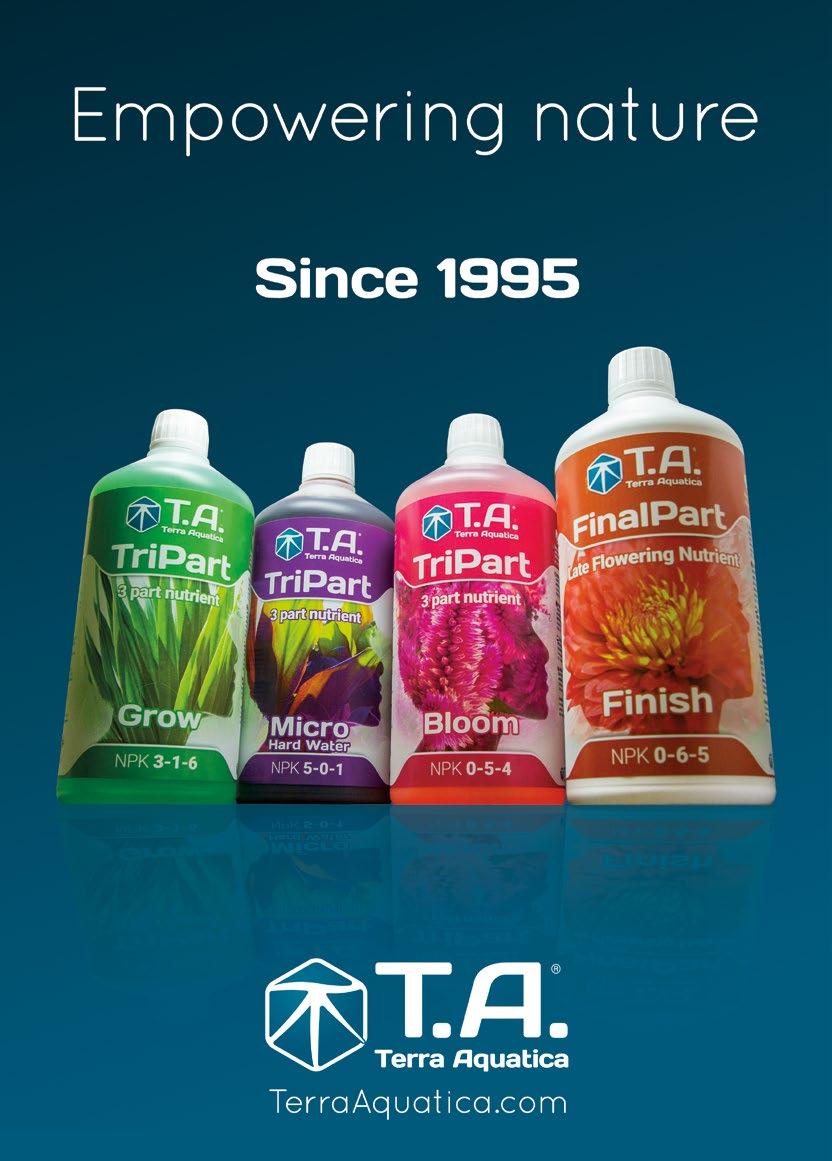
FOREWORD CREDITS
After ten years of publishing Garden Culture, we have seen many fads come and go. Some stuck, others did not. Some of the biggest trends that genuinely changed the game were the introduction of coco coir as a substrate, microbes as a supplement, and LED grow lights. There is another craze booming outside our industry, and it’s mushrooms. The global mushroom market was valued at $58.8 billion in 2021 and will reach an estimated $86.5 billion by 2027, according to market research firm IMARC (imarcgroup.com/mushroom-market). The year 2022 was not the best for indoor gardening shops or the companies that manufacture and supply the products they sell. Can mushroom cultivation be a new product category that helps our local hydro shops succeed? I hope so.

If you have been growing for years and have never tried growing mushrooms, NOW is the time. Not only are they fun and a beautiful thing to grow, but they are also super healthy and delicious. This edition has articles to motivate and educate you on how to do it.



If mushrooms are not for you, don’t worry! This issue also contains valuable and interesting information, such as how best to use vermiculite and seaweed in the garden. Take a look at which microbes reign supreme and discover who wins the substrate battle in “Soilless SmackDown:
Peat Moss versus Coco Coir” by Av Singh. Adam Clarke’s “Airflow And Its Importance In All Grow Rooms” will be a breeze to read and give your plants the environment they crave and you the garden of your dreams.
Happy growing, and remember to get out and support your local grow shop. They need us more than ever. So pick up a mushroom growing kit, and let us know how it goes!
SPECIAL THANKS TO:
Adam Clarke, Anne Gibson, Av Singh, Chris Johnson, Cody J. Garrett-Tait, Emma Carter, Jennifer Cole, Jesse Singer, Joanna Berg, Martin Osis, Martyna Krol, Catherine Sherriffs, Xavi Kief, & Progrow Exeter.
canna-uk.com
DESIGN
Job Hugenholtz job@gardenculturemagazine.com
DIGITAL & SOCIAL MARKETING social@gardenculturemagazine.com

ADVERTISING ads@gardenculturemagazine.com

PUBLISHER

325 Media INC
44 Hyde Rd., Mille-Isles QC, Canada J0R 1A0 GardenCultureMagazine.com
ISSN 2562-3540 (Print)




ISSN 2562-3559 (Online)

Garden Culture is published six times a year, both in print and online.
@GardenCulture @GardenCulture
@GardenCultureMagazine @Garden_Culture
DISTRIBUTION PARTNERS
Creation Wholesale One Love Inc
• Highlight Horticultur e
• IKON
© 325 Media rights reserved. No part of this publication may be reproduced, stored in a retrieval system or transmitted any form or by any means, electronic, electrostatic, magnetic tape, mechanical, photocopying or otherwise, without prior permission in writing from 325 Media Inc.

11 GARDENCULTUREMAGAZINE.COM
FOREWORD & CREDITS
The gods must be crazy
The gods must be crazy Mushroms,Microbes &M THE ART OF GROWING GARDEN CULTURE
Visit us at GCMag.co and read ten years’ worth of timeless gardening
ROKZ-SOLID AND FROSTY RESULTS!
No matter what medium you choose to grow on, Rokzbastic ensures ROKZ-solid and frosty results!

Unique P:K ratio


of 1:2 compared to other liquid flowering products on the market

PK 10-20: The proportion of potassium is double that of phosphorus to make your flowers and fruits firmer
Minimal dosage, great results

@atami.uk AVAILABLE SIZES: 50 ML, 100 ML, 325 ML, 1250 ML, 5.5 L, 10 L
This summer, one mushroom took my breath away: Mycena acicula is a tiny little mushroom that almost glowed with an intense red cap and a micro thread-like stalk that was practically fluorescent yellow

Author Spotlight
We’re thrilled to have Martin Osis as a Garden Culture contributor, especially when it comes to exploring the incredible world of mushrooms.
Martin is an amateur mycologist who has been educating mushroom enthusiasts for decades, but there’s nothing ‘amateur’ about him! The dude knows his stuff. Check out his article about the many medicinal benefits of mushrooms on page 56.

Is there a motto you grow or live by?
Not a motto as such but more of a state of being. When I am in the wilderness, it bathes all my senses. I stand and see a leaf etched on a rock from the fathoms of time, a hawk soaring free and imagine the mycelium pumping under my feet, feeling the life force around me.
What drew you into the world of mushrooms?
My first outings in the woods were picking mushrooms with my family. Mushrooms are so mystical and spring from an invisible world out of my view. Like Einstein said when asked why he was interested in Physics - he wanted to figure out how God did it. Plus, serendipity drops a rare, choice, edible mushroom in my basket from time to time.
What is one of your favourite mushrooms?
Favourites are difficult, as there are edible mushrooms and medicinal mushrooms that I enjoy and turn to regularly. But this summer, one mushroom took my breath away: Mycena acicula is a tiny little mushroom that almost glowed with an intense red cap and a micro thread-like stalk that was practically fluorescent yellow. The tiny thread curves and twists up and around to bring the mushroom cap above the world’s detritus. This keeps the cap perpendicular to the ground and in the breeze to distribute its spores. This mushroom only fruits about once a decade in my area, so seeing it is a real thrill!
What is your favourite food?
Wild foods. Many of these are priceless as you can’t just go out and buy them, but you can earn them. Foraged, fished or hunted, you never know what will grace your plate, if anything at all. These ingredients never go to waste and are treated with the deepest respect and culinary care in my kitchen.
Where in the world would you like to travel to next?
Foray Newfoundland or the next NAMA (North American Mycological Association) Foray. These mushroom forays bring you to interesting places with interesting mushrooms and even more interesting people.! 3
Are you interested in writing for Garden Culture Magazine? We’d love to hear from you! Send us an email introducing yourself with a sample of your work. editor@gardenculturemagazine.com
AUTHOR SPOTLIGHT 13
Martin Osis
Mycena acicula

NEW YEAR, NEW SHOGUN MULTIPACKS



Shogun introduces a new range of multipacks in a cool and fresh design. As part of this launch, the design of the bestselling Coco Multipack has been upgraded. But that is not all! Shogun is thrilled to welcome new products to the multipack range: Terra Multipack, 3-pack, and 2-pack that will offer great value to customers while giving them the convenience of buying multiple items at once. Great value as well as new durable packaging for each box to protect the precious cargo inside. There is no better way to start with Shogun than these new multipacks.
learn more about
Full On by GROW SWITCH
A new proprietary nano ionic nutrient additive that sets new levels of nutrient uptake and conversion to new cell divisions and overall plant growth and works with all NPKs.

Full On can reduce cycle times by one to two weeks in all growing environments and with all nutrient packages while consistently improving genetic expression, terpenes, and weight. Commercial growers using Full On have increased their annual production by 25% to 35%.
Grow Switch Full On is available in 60ml and 250ml.
Inquire at your
Advanced Nutrients Multi-Packs
The new multi-packs make exploring the most sought-after the Advanced Nutrients line easier than ever. With three multi-packs choose from, you can put these tried-and-true formulations your garden.
The Bigger Buds Tri-Pack, includes Bud Ignitor®, Big Bud Overdrive® in 250mL. The pH Perfect® Bloom Tri-pack pH Perfect® Sensi Bloom Parts A&B in 500mL and Big Bud® in 250mL. Finally, the Foliar Four-Pack with Bud Ignitor®, B-52®, Bud Factor X® and Nirvana® in 250mL.
Ask for the multi-packs at your local grow shop. Visit AdvancedNutrients.com for more details on each product.

15
grow store. Be sure to follow
for new gardening products.
favourite
@highlighthorticulture
Firefly LEDs Bring The Sun Inside!

There is no question about the power of the sun! The Firefly LED brings the sun to you! The LED grow light fixture imitates the sun’s spectrum during springtime around noon (when the sun’s power is the strongest). The UV-A in the spectrum helps to develop fruits and flowers, which benefits flavour development. So don’t ask yourself how much light you give your plants, make sure they get the light spectrum they need.
Visit Fireflygrowlight.com for more info. Use the code GC2023 to get a 30% discount!
Voodoo Tablets

Check out GrowYourHydroponics.business for more info.

A product designed to use during the last weeks of flowering, ROKZBASTIC’s unique PK 10-20 ratio gives what your plants need to produce firm, full flowers and fruits. Potassium and phosphorus are essential at this stage of the plant’s life. Phosphorus ensures the plant stays energised during the flowering, fruiting and ripening phases. Potassium helps strengthen the plant’s ability to resist disease and plays a vital role in increasing crop yields and overall quality.

Go to ATAMI.com to discover the complete line of Bastics.

An entirely bio-degradable, all-natural blend of plant extracts that is not hazardous to human health or the environment and boosts growth and vigour in practically every area of the plant without altering your EC.
Moonshine Nutrient Enhancer’s unique formulae make it the perfect partner for any other nutrient line, enhancing the performance of existing products without altering the feed strength.
With this organic booster, expect to see more robust root systems, quicker flowering times, bigger fruits, better aromas and plants with increased resistance to stress!
Head down to your local grow shop and follow @highlighthorticulture for more great products.
ATAMI ROKZBASTIC Moonshine Nutrient Enhancer 16
The long-awaited Voodoo Juice Plus tablets from Advanced Nutrients are now available! Voodoo Juice Plus tablets combine the power of Piranha,Tarantula and, of course,Voodoo Juice into a quick-dissolving 1-gram tablet which treats up to 378 litres. Each tablet unleashes 10 billion CFUs of beneficial bacteria and fungi into the root zone, which helps build root mass, increase flowering potential, and oil production—a very effective and simple-to-use product.
I love your products!!!
I noticed a difference right away
love this stuff!
The optic foliar line actually works! I noticed a visible difference in my plants within 2 days. I highly recommend this product.


great!!
Saw results after first use no BS. just give it a try
10X easier
Your products make my routine 10x easier being able to spray with LIGHTS ON!
It really works!
THIS SPRAY REALLY WORKS.!!!! Will buy again
No Damage No Burning No Residuals Ready To Use & Concentrate
on spray.
Over 22 year experience providing guaranteed foliar spray solutions SALES@OPTICFOLIAR.COM
839 727
Original the Lights
Also flower safe!!!
01949
Red Scorpion E.C. Fans
When it comes to fans, the latest tech doesn’t necessarily need to cost the earth. Combining highly efficient E.C. motor technology with solid, no-frills construction, Red Scorpion has produced a great value option for growers looking to save money without compromising performance. They boast impressive airflows across the range, and thanks to their E.C. motors, you’ll never hear a buzz or a hum when the fan speed is turned down.

A speed controller is included with every fan, but it can also be thermostatically controlled with compatible environment controllers. Available in sizes from 5” to 10”.
For more great products, visit GrowYourHydroponics.business
Tray2Grow from AutoPot
A completely automated, power-free system that offers you five ways to feed and water your plants.The Tray2Grow can accommodate seed trays, small pots, grow bags, micro herbs, and planters, making this the most versatile product in the AutoPot range and one of the most flexible irrigation systems.
Equipped for every eventuality,Tray2Grow includes optional capillary spikes that can be fitted inside the tray.These pierce the underside of a grow bag, allowing you to irrigate the substrate. With the spikes removed and capillary matting in place, Tray2Grow can take up to four standard-sized seed trays, any number of bottom-perforated or bio pots, coco slabs, or AutoPot’s capacious 120 L framed fabric planter.

Check out AutoPot.co.uk for more great gravity-fed systems.
BudBox
White XL-HL (120x120x220cm)

The world’s most popular grow tent size from the UK’s Number 1 manufacturer - BudBox. Six consecutive years as gold winner mean this XL-HL (120x120x220cm) PRO white model is the best you can buy. Class-leading PAR reflectivity (up to 106% MORE than mylar), frame strength (25mm poles) and a vast range of features make this the choice for anyone seeking the best yields, year after year.

Main doors, access doors, eight port options in 4 sizes, uplift irrigation bar, night vision viewing window, micro-mesh screened passive vents, roof bars, all metal push/click connectors, drip tray, and so much more.
Check out BudBoxGrowTents.com
19
Cocos Premium 100% COCO Substrate

Plagron’s Cocos Premium is a fully buffered coconut substrate with a stable pH value. Suitable for fast-growing plants, Cocos Premium meets the highest quality standards. A low EC value is guaranteed, preventing fertiliser burn. Cocos Premium also has excellent water retention and is free of sand, weeds and pathogens. Plagron coco substrates are clean and pure and can be used safely without risk to your grow.

Visit Plagron.com for more info.
Optic Foliar EVIOS

Say goodbye to residuals and odours with Optic Foliar EVIOS. A new style of natural pest control that utilises non-traditional plant extracts to make your garden flourish. The non-oil based, no-odour solution will become an integral part of your IPM. You can apply it in full sunlight without spraying the undersides of the leaves.
Visit your local grow shop and follow @highlighthorticulture for more great products.

20









































imitated, never equalled canna-uk.com/boost
Often
Confessions of a UK Hydro Store Confessions of a UK Hydro Store





Brand new to the pages of Garden Culture Magazine, Confessions of a Hydro Store strives to connect you with the grow shops selling your favourite products (and offering your favourite magazine!). In today’s world, the sense of community amongst growers is more important than ever. In our second edition of this segment, we’d like you to get to know Progrow. With two locations in Exeter and Plymouth, Progrow has been serving customers for over 20 years and has witnessed the many changes that have affected the industry.


#gardenculturemagazine #confessionsofaukhydrostore #gardenculturemagazine #confessionsofaukhydrostore
22
With over 20 years of serving the public, what has changed and what hasn’t? When we started, we had the luxury of being the go-to place for information and equipment. The continued dominance of the internet in our lives has naturally affected how we get information and buy products. For example, if you wanted a grow light 20-30 years ago, you went to a grow shop. Now, you can buy them from anywhere in the world, and the same goes for hydroponic equipment. There are about 500 grow shops today; there were about 150 when we started.
The amount of equipment available has grown exponentially in our time, and the technology has gone through the roof, mainly due to the legitimacy of the U.S. scene, shall we say. Unfortunately, there also doesn’t seem to be a younger generation of growers coming through, which is a bit worrying, but maybe it’s because they are buying online!
What is your take on Nutriculture going out of business? Everybody in this industry knows that these are challenging times. We have the utmost respect for Nutriculture. They were more than innovators; they forged a path and created a business way ahead of the curve in the U.K. They were an essential supplier for anyone considering hydroponic retail. We have sold thousands of their systems, and that’s just us in our little corner of the world.
When a company becomes bigger with more staff, maybe things get harder to manage, or it’s not quite as ahead of the curve as it was. You have to evolve in an evolving market, and maybe Nutriculture didn’t react fast enough. Grow tents became popular, and the older systems tended to fit awkwardly.
How has Brexit impacted your business? I don’t see how anyone in business could think that restricting trading with our 28 closest neighbouring countries is positive. We’ve found stock orders from Europe take two weeks now when it was two days. The same goes for despatching orders to Europe; it takes longer, is more expensive, and there are more forms and declarations to fill in. So we are indirectly paying the extra costs in shipping through price rises of stock from abroad.

What music plays in the store? We have impeccable music taste and try our best to educate the staff with Radio 6 on the BBC. Aran, in our dispatch department, listens (unfortunately for my ears!) to Kerrang Radio, which plays music that resembles someone drunkenly falling over bins in an alley whilst trying to summon the devil. Yet, somehow, he plays this music to people at gigs; he’s available for weddings, bar and bat mitzvahs, birthday parties, and other events.
How do you try to make your shop stand out? When we started, I remember wondering if we had enough knowledge to advise people properly. So we made sure we did; it pays dividends again and again if you can inform customers correctly. If someone’s new to
hydroponics, it’s pretty bewildering, similar to learning a new language. So we’ve taken many customers step-by-step through growing successfully over the years—knowledge backed by good stock, in stock. We get online orders to customers quickly and efficiently, again, something you can only do if you have the inventory. Beyond being knowledgeable, we are professional and friendly and don’t sell ‘gimmick’ products.
What is the most common question asked by customers? Currently, they want us to price match x-y-z or want to know if we have various products in stock. It’s impossible to keep all lines in stock, and of course, we’ll do our best to get things specifically for customers if we can. And we were one of the first in our industry to offer a price match.
How do you create customer loyalty? Good service and fairness, coupled with knowledge and stock are the only options. Over the years, we’ve had loyalty schemes and tried to encourage online accounts, with no significant uptake. Lockdowns got customers more accustomed to ordering online, so customer loyalty is down.
What has been the biggest challenge of running the shop? Managing staff without a doubt, paying taxes and feeling like you’re getting nowhere, and adapting to the changing world and market. The business has been fortunate to have some outstanding employees over the years and probably has its best staff right now. There’s a lot of investment that goes into training staff. You also need to trust the person you employ to handle customers you’ve worked hard to gain. Also, when you work so hard and have such a huge chunk taken in tax, it does make it very difficult to keep going. The changing market mainly revolves around customers shopping from their phones and the rising costs of running a retail establishment.
Looking back, would you have done anything differently? I don’t think I would have done anything differently. We started our business at a good time as the only outlet in the area. We worked hard and put everything into it. We established a good online business and we’ve been successful for over 20 years, so I try to be grateful for what it’s given me and want for nothing. 3
When we started, I remember wondering if we had enough knowledge to advise people properly. So we made sure we did; it pays dividends again and again if you can inform customers correctly.
Figure 1
Want to be the next Hydro Store to ‘confess’? Take a picture of this edition of Garden Culture Magazine in your shop, post to Instagram and tag @gardenculturemagazine. OR Send your info to social@gardenculturemagazine.com 23 UK HYDRO STORE
Vermiculite Benefits of and How to Use in your Growing Mediums

Create custom potting mix blends by combining vermiculite with other ingredients like sand, compost, vermicast or coir peat

BY ANNE GIBSON 24
What is Horticultural Vermiculite?
Vermiculite is a naturally occurring volcanic silicate and multi-layered clay mineral closely related to mica. It is mined in many countries, including Australia, the US, South Africa and Brazil. During the heating process, the mineral expands as the layers separate.The resulting substrate is known as exfoliated vermiculite. It is graded into different sizes based on diameter. The accordion-shaped brown-grey coloured granules range from extra fine (0-1mm) to fine (2-4mm), medium (3-6mm) and coarse (5-8mm). Vermiculite is helpful in various applications due to its many attributes.
Properties and Benefits
Vermiculite has many beneficial characteristics that make it extremely useful for home gardeners and growers, particularly in growing mediums:
• It is clean; odourless; non-toxic; highly porous, and won’t become mouldy, rot or decompose. Vermiculite can be expensive but provides long-lasting value.
to its many attributes
• It is sterile and pathogen-free, so it is ideal for seed-raising media to avoid damping-off diseases.
• It can hold air and make minerals and nutrients available to plants.
• It has a strong capillary action that can absorb three to four times its weight in water.
• It increases the water-holding capacity of potting soil blends and seed-raising mixes, reducing the need to water as frequently. It behaves like a sponge, releasing moisture slowly. This characteristic is particularly valuable in hot, dry climates or during drought and for thirsty plants that do best in consistently moist soil.
• It has a high CEC (cation exchange capacity). Vermiculite has a negative charge and attracts positively charged ions. As a result, macro minerals like calcium, magnesium and potassium are released from the particle surface to slowly release vital nutrients to plant roots.
• It is lightweight and inorganic, making it ideal for balcony gardeners or renters where a lightweight mix is required in pots or for people on the move.
• It is a permanent ingredient that will not deteriorate or lose volume in the mix.
• It has thermal properties, which can be very useful to insulate plant roots from high or low-temperature fluctuations. In hot climates or for frost-tender plants, this ingredient can be a lifesaver!
• It typically has a fairly neutral pH, ideal for adding to soil and growing mediums.
• It improves the structure of soil and growing mediums. Larger vermiculite particles increase aeration and enhance the composition of heavy, compacted soils.
• It can substitute perlite in growing media for many applications.
• It is inert, so it is non-reactive to other materials.
Vermiculite Uses
These unique characteristics make vermiculite a very beneficial product in the garden. Here are a few ways to use it to your advantage:
Soilless growing substrate: Create custom potting mix blends by combining vermiculite with other ingredients like sand, compost, vermicast or coir peat. It’s an ideal growing medium for hydroponics for plant support, moisture retention and nutrient release (Voropaeva et al., 2014).

Seed germination: Vermiculite can be used as a moisture-retaining cover layer to help seeds germinate or as an ingredient in a seed-raising mix.

25 VERMICULITE
Vermiculite is helpful in various applications due
25
A blend of vermiculite and coir is often used for striking cuttings
Vermiculite can be used in potting mix to raise vegetables
Vermiculite can be added to heavy clay soils to improve aeration and structure
Store root crops or bulbs: Placed in a container and surrounded with vermiculite, you can extend the harvest life of root crops and prevent bulbs from rotting during storage. It will absorb excess moisture from outside the crops or bulbs, and the thermal properties insulate them from temperature fluctuations.
Soil improver: Vermiculite can be added to heavy clay soils to improve aeration and structure. Mixed into sandy soils, it helps retain soil moisture and nutrients.
Propagating cuttings: Medium-grade vermiculite is an ideal propagation mix on its own or in combination with coir peat, compost or vermicast. It provides excellent drainage and aeration properties, helps to anchor roots, and holds nutrients and moisture to promote new growth.

Tips for Working with Vermiculite
• The pH of vermiculite can vary depending on the brand and is sometimes slightly alkaline. It’s a good idea to check your potting or seed-raising mix with a soil pH test kit before using. If needed, blend with slightly acidic ingredients to balance the pH.
• Due to its moisture-absorbing properties, vermiculite may not be the best choice as an amendment in growing mediums for succulents or plants that require a drier mix. Drought-hardy species only need minimal soil moisture, so a higher proportion of sand to coarse-grade vermiculite would be appropriate.
• Fine-grade vermiculites help retain water in the growing media. This aids seed germination, but the fine particle size can also impact aeration properties. Therefore, it’s essential to choose a suitable grade for the job. So, vermiculite must be balanced with other ingredients in seed-raising mixes, such as sand and sieved compost or vermicast, to ensure adequate oxygen around the root zone.
• Coarse-grade vermiculites have a larger particle size. These granules help aerate growing media but have lower water-holding capacity than fine-grade.
A variety of vermiculite grades are used for different plants - ideal for propagating succulents


Safe Handling
Vermiculite is a dry mineral; bags can contain fine dust, so keep them closed when not used. Work outdoors on a non-windy day or in an area with good ventilation. Keep vermiculite damp during use to minimise dust. Store it in a cool, dry place with adequate air circulation out of the sun. You can also wear gloves and a mask to prevent potential irritation.
With many benefits and applications, vermiculite is a substrate worth using in your garden. 3
BIO Anne Gibson, The Micro Gardener, is an author, speaker and urban garden community educator on the Sunshine Coast, in Queensland, Australia. Anne is passionate about inspiring people to improve health and wellbeing, by growing nutrient-dense food gardens in creative containers and small spaces. Anne regularly presents workshops, speaks at sustainable living events, coaches private clients and teaches community education classes about organic gardening and ways to live sustainably. She has authored several eBooks and gardening guides. Anne shares organic gardening tips and tutorials to save time, money and energy on her popular website - TheMicroGardener.com
2727
VERMICULITE
Vermiculite is an ideal ingredient in seed raising mix and to raise microgreens


Now exclusively supplied by
the History of mushroom Consumption
Whether feared as poisonous or honoured as a gift from the Gods, humans have had a long and varied history with mushrooms. Especially when it comes to our consumption of them or lack thereof. Let’s walk through a timeline of our history of mushroom consumption.
The Red Lady
In 2010, the remains of a woman - dubbed the “Red Lady” - were found in a burial site dating back nearly 18,700 years. An examination of her dental calculus found evidence of mushrooms in her diet.
3,400-3,100

The mummified remains of a hunter-man, Otzi, who lived in Europe between 3,400 and 3,100 BC, were found with three different kinds of fungal objects. While one may have been used to start fires, the others were likely for medicinal purposes.


BY JESSE SINGER
30
16,700 BC: Otzi
BC:
Egyptian Royals
In Ancient Egypt, mushrooms were considered so special, a gift from the God Osiris, that they were reserved for royals and their families. Common folk were not allowed to eat mushrooms or even touch them!


480 BC:

Magic Mushrooms
In Ancient Greece, philosophers such as Plato, Homer, and Aristotle, were said to attend secret ritual ceremonies worshipping the goddess Demeter, which involved drinking psychoactive concoctions containing psychedelic mushrooms.
200 BC:
Mushroom Cultivation In Greece
Greek horticulturalists begin growing mushrooms to learn more about their practical uses. In an essay called Concerning Odors, the Greek scientist Theophrastus wrote that fungi grown on dung was not stinky and could be eaten. His student, Nicandros, learned and spread the good word about growing mushrooms in manure-filled holes under fig trees.
1,500 BC:
3,100-300 BC: Central America and Psilocybin
Artwork in Central America portrays mushrooms as a way to communicate with the Gods. Mayan and Aztec people used psilocybin in religious ceremonies for various celebrations and spiritual and physical healing.


450 BC:
Mushroom Medicine
Hippocrates, the “Father of Medicine” himself, wrote about the amadou mushroom as an effective anti-inflammatory and ideal for cauterising wounds.
100 BC:


Mushroom Medicine in China
Ancient Chinese texts dating back to 100 BC discuss several of today’s popular mushrooms, pointing out their ability to cure multiple diseases, including respiratory illnesses.

3131
MUSHROOM CONSUMPTION - A TIMELINE
900 PROPAGULES PER GRAM,

YOU WILL NEVER GROW WITHOUT IT AGAIN.
DISTRIBUTED BY:




WWW.DYNOMYCO.COM
The 1300s:
Mexican Religious Ceremonies
The Mixtec Vienna Codex, which dates back to the 14th the use of mind-altering mushrooms in ancient Mexican religious ceremonies.


1422:
The death ofEmperor King Charles VI

King Charles died on October 21st, 1422 - possibly from eating amanita or death cap mushrooms. Leading famed French Philosopher Voltaire to say, “A dish of mushrooms changed the destiny of Europe.”
1519:
Seeing the Future
Following the conquest of Mexico in 1519, Roman Catholic priests witnessed Indigenous peoples consuming hallucinogenic mushrooms. They would wait for the effects to wear off and then discuss their visions for the future.
1650:

Western Cultivation
Mushrooms had been cultivated in the east for hundreds of years. But the first record in the west happened around 1650 in Paris, France.
1790:
Attempt to Cultivate Truffles
Frenchman Pierre II Mauléon of Lou dun began to cultivate truffles around 1790. Recognising the correlation be tween the oak tree, the rocky soil, and the truffles, Mauléon attempted to recreate the environment by taking acorns from truffle-producing trees and sewing them in chalky soil.

1824:
Published in 1824, “The Virginia Housewife” contains the first references to mushrooms in a cookbook in the United States.


1755-1826:
Brillat-Savarin and Truffles
Brillat-Savarin, a father of the gastronomic essay, once called truffles the “diamonds of the kitchen”.

33
“The Virginia Housewife”
MUSHROOM CONSUMPTION - A TIMELINE
Trust and Quality, for the most demanding growers

American Cultivation
It was around 1865 that mushroom cultivation started in the United States.

1865: Cooking With Mushrooms


Before this time in the United States, mushrooms were primarily used in condiments. However, once cultivation began stateside, Americans started cooking them up in their kitchens.
“One Hundred Mushroom Receipts”
1899: Mushrooms on Pizza

Lepiota procera Stew and Baked Tricholoma personatum are just two of the 100 recipes in Kate Sargeant’s “One Hundred Mushroom Receipts” cookbook. This is one of the first English-language cookbooks dedicated to the mushroom.
1911: Italian Brown
Until the early 1900s, pizza was primarily sweet, not savoury. In Pellegrino Artusi’s classic cookbook, ‘La Scienza in cucina e l’Arte di mangiar bene’, he had three pizza recipes, all of them sweet! However, after reader feedback, Artusi added a typed-up sheet to the 1911 edition with a recipe for a savoury ‘Pizza alla Napoletana: mozzarella, tomatoes, anchovies and mushrooms.
Now known as Crimini, the Italian Brown was the most widely available mushroom before 1940.

1934:
Before 1940: Japan’s Shiitake Discovery

Campbell Soup

A staple in many kitchen cupboards these days, the Campbell Soup Company introduced their famous Cream of Mushroom in 1934.

The 1960s:
In a study charting diseases throughout the country, Japanese researchers discovered two remote areas where incidents of cancer were shockingly low. Eventually, this epidemiological phenomenon was linked to the predominance of Shiitake mushrooms in their diets.

MUSHROOM CONSUMPTION - A TIMELINE 35
GREAT FLOWER COMES FROM POWDER

CRAFT POWDER BASE NUTRIENTS & ADITIVES













Distributed in the UK by
1969:
Cancer Drug

In 1969, the pharmaceutical compound Lentinan was extracted from shiitake mushrooms. It’s now the third most widely prescribed anticancer drug in the world.
The 2010s:
White Buttons Rule
According to a report from the Mushroom Council in the 2010s, white button mushrooms are far and away the most popular variety in the United States. They represent 90% of all mushrooms consumed in the country.

2019:
11.9 million tonnes
The worldwide production of commercial mushrooms and the recorded amount of collected truffles weighed in at 11.9 million tonnes in 2019.
October 15th:
National Mushroom Day
We aren’t sure when it started or who started it, but October 15th is National Mushroom Day.
Sources:
• pbs.org/food/the-history-kitchen/edible-mushrooms

• foodprint.org/real-food/mushrooms
• wikipedia.org/wiki/History_of_pizza
• wikipedia.org/wiki/Cream_of_mushroom_soup
• lowimpact.org/info-articles/history-of-mushroom-cultivation

• Blog.naturalwellbeing.com: bit.ly/3UGwU89
• ncbi.nlm.nih.gov/pmc/articles/PMC4684114
• spiritofchange.org/a-history-of-medicinal-mushrooms
• mpg.de/9173780/mushrooms-food-source-stone-age
• wikipedia.org/wiki/Edible_mushroom
• wikipedia.org/wiki/Truffle
• Mycologistkat.wordpress.com: bit.ly/3HnJx4T
• Tastingtable.com: bit.ly/3UL3HJn

• nationaltoday.com/national-mushroom-day
• Crazyaboutmushrooms.com: bit.ly/3FEB1gN
• Mushroomrevival.com: bit.ly/3iQqW7B
BIO Jesse grew up obsessed with movies and so it only makes sense that he graduated from McGill University with a degree in Political Science. He then put that degree to good use with a job at a video store. After that, he spent months backpacking around Europe - a continent that he has been back to visit many times since. Jesse is super curious and loves to learn and explore new subjects. For the last 15+ years, he has been writing online for a number of different sites and publications covering everything from film and television to website reviews, dating and culture, history, news, and sports. He’s worn many hats - which is ironic because he actually loves wearing hats and he has many different ones.
MUSHROOM CONSUMPTION - A TIMELINE 37
Lentinan
Setting the Stage For
Mushroom Cultivation Mushroom Cultivation
Whether starting from a spore or pre-inoculated kit, cleanliness will be a significant factor in the success of your first grow.
Like mushrooms, mould and bacteria also love nutrientrich substrates and will almost always out-compete the fungus you are trying to grow

BY CHRIS JOHNSON 38
Cordyceps militaris cultivation
Mushrooms love a nutrient-rich grow substrate to spread their mycelial “roots” and absorb the nutrients around them. Like mushrooms, mould and bacteria also love nutrient-rich substrates and will almost always out-compete the fungus you are trying to grow. Ensuring you have a clean substrate is integral for the success of your first grow, but this article will focus on the importance of giving the mushrooms the best environment possible, and that starts with where we do our lab work.

Small Spaces And Cleanliness
When I was an amateur grower starting to get my hands on the tools and inoculating my grow substrates, my 4’x8’ bathroom quickly became my “clean” room. A small space in your home with little to no foot traffic will be the best place to get your athome mycology work done because it will be the most accessible place to keep clean. And remember, we do not need to take over a room in your home permanently; this is only necessary when doing the clean work portion of mushroom cultivation.
The smaller the room, the better. You want to have the space shining from floor to ceiling, and less space means less time cleaning. Depending on your budget, the most common cleaners are Lysol sprays or bleach. When working with any cleaner in a small, sealed environment, it is vital to wear the appropriate attire to keep yourself safe; I recommend gloves, glasses, and a face mask.
Now that we have our space dialled in, we need to bring in our tools and supplies. As you clean or bring items in, it is essential to wipe them all down with a 70% Isopropyl alcohol solution and allow it to evaporate completely before using them.
Personal Hygiene
After you have identified a place in your home, cleaned it from top to bottom, and have all your tools and supplies, it is time to think about the most significant vector of contamination: you! Humans are walking vessels for moulds and bacteria to latch onto, whether it be on your clothes, hair, or even the spit particles that leave our mouths as we talk. No matter how much work and preparation you put into cleaning your environment, you must remember to ensure you are as clean as possible. Before doing at-home lab work, I recommend you shower, dawn a fresh set of clothing, tie up your hair
(if applicable), and remove any jewellery before we step into our homemade lab.
Once we set foot into the lab, putting the appropriate PPE on is essential. Basic PPE is a set of disposable gloves and a surgical mask. The gloves will help prevent bacteria or dirt trapped in your fingernails from dislodging while working, and the surgical mask will prevent spit particles from landing on your tools or sterilised substrates.
A Winning Workflow
Proper workflow is the next step to consider when growing mushrooms. Doing all the work in an orderly fashion, moving from the left to the right, will prevent us from reaching back over the top of something that can be contaminated. For example, suppose I plan to spawn bulk substrate in a bag. In that case, I will set up my scissors, isopropyl alcohol, and paper towel on the far left, followed by my bag of spawn, a bag of the substrate, and lastly, my bag sealer on the furthest to the right side of my workbench. This will allow me to use the clean scissors to slice open the two bags, transfer the contents of one bag into the other, and seal the bag with a bag sealer - all without having to reach back over to grab a tool and potentially contaminate a vulnerable open bag of the substrate.
Take Five
Setting yourself up for success in the lab is time well-spent, as five minutes of prep work can save you two weeks of colonising a substrate only to realise it has been contaminated the entire time. Being intentional with your actions and having a proper game plan will bring you success in all of your myco-endeavours. 3
3939
GROW ROOM HYGIENE
five minutes of prep work can save you two weeks of colonising a substrate only to realise it has been contaminated the entire time
BIO Chris Johnson is a business professional and amateur mycologist working in the Canadian psychedelic industry. Chris is passionate about making mushrooms and mushroom cultivation more approachable for the everyday myco-curious person.
As the topics of climate instability and global food insecurity demand urgent attention, regenerative growing practices are being adapted and scaled to address the interconnectedness of human and non-human survival on this planet.

40 BY XAVI KIEF
Living kelp forests are home to incredible biodiversity

Like land-growing plant groups such as grasses or trees, seaweed is a generic name for many species. In the last several decades, emerging technologies and research have revealed the underappreciated diversity and activities of fungal and bacterial organisms. At the same time, nearly every industry has found novel opportunities to enhance the human experience by working with seaweeds. Their unique characteristics attract people seeking creative solutions in healthcare, food, and environmental wellness.
Feeding the World
Seaweeds have long been collected and cultivated as a primary food source for humans and their companions. Now, AI is used to identify textures and flavours inherent in animal-based products and mimic those using derivatives of land and ocean-growing plants. These “meaty” products can be derived from plants grown with regenerative land-use strategies that incorporate seaweed to produce more appealing, nutritious food.
Of course, coastal agriculturalists have long worked with seaweed and other marine source materials in localised traditions of integrated resource and sustenance management, defying and complicating concepts of boundaries between living lands and waters.
On the Surface
From a land-based human farmer’s point of view, seaweeds are analogous to other domesticated crops. A few countries and locales have historically exploited their natural resources to evolve industrial methods of high-volume cultivation and harvest. The same vulnerabilities and concerns exist within seaweed agriculture, including risks associated with monocropping and genetic intervention (whether through traditional breeding or genetic modification), which allow shortsighted economic gains to take precedence by reducing diversity, threatening ecological balance and future yields.
Like any other agricultural input, when macroalgae are collected and used without regulatory oversight and testing, there is a potential for contamination by bioaccumulation, the redistribution of heavy metals or other chemical pollutants, and ecosystem disruption. Living kelp forests are home to incredible biodiversity. Mammals such as whales, sea lions and otters use them for food and refuge from storms and predators, as do countless fish species and invertebrates like sea urchins, slugs, snails, stars, sand dollars, and octopi.
Sustainability concerns and other pressures have created a global regulatory environment in which seaweed cultivation and wild harvesting are subject to radically different and sometimes seemingly over-complicated schemes. These prevent some stakeholders in countries like the United States from being able to jump in and start farming the oceans. At the same time, the European Commission, Scotland, India, and other nations are openly exploring opportunities for industrialising seaweed as part of integrated hunger-reducing programmes. They cite proof of land-crop yield improvement and spacial use efficiency (i.e. farming kelp in coastal areas already disturbed and depopulated due to windfarming and other human activities) as additional and significant benefits to investing in this sector.
From Forests of Macroalgae to Botanical DNA: Deeper and Deeper Down
Thanks to the generational transmission of traditional ecological knowledge, some contemporary environmental stewards know how to work regeneratively with wild sea plants in their regions. These practices include respecting the growth habits of different types of seaweeds and employing multiplicative techniques similar to coppicing, “pinching back” or topping, while leaving the rock-affixed bases of the plants intact. However, because beach and ocean detritus like rocks and shells comingle with storm-tossed seaweed, machine collection of this resource is generally not considered commercially viable. Instead, these deposits are often available to small-scale hand pickers operating either on their ocean-adjacent properties or with permission from the supervisory bodies that govern other types of wild harvest (e.g. hunting, herbcraft).
In other locations, the public interest is cited as a reason for “cleaning up” significant quantities of beached seaweed, offering the opportunity to employ this otherwise “nuisance” or “waste” in nearby food production and land rejuvenation strategies. In addition, these materials can be valuable to those seeking to repair or improve soil quality for cultivation.
A Substrate Amendment Worth its Salt
When seaweed biomass is incorporated as a compost amendment or mulch, the structural effect is increased water-holding capacity, aiding in wind erosion control and allowing more efficient use of unpredictable rain and cherished groundwater resources.
SEAWEED
4141
Sustainability concerns and other pressures have created a global regulatory environment in which seaweed cultivation and wild harvesting are subject to radically different and sometimes seemingly overcomplicated schemes
Growers can observe or imagine chopped seaweed mulch working like other mucilaginous materials, hydrating and holding moisture between soil particles.
Although transferring large quantities of raw, unwashed seaweed will introduce some sand and salt to the land, it more than makes up for this by adding other minerals and beneficial compounds to the mix. Composting seaweed with sawdust is one inexpensive and balanced approach to building soil.
Seaweed concentrates are not merely nutritional supplements and do not create such a strong effect on plants simply by increasing the local food supply; they contain phytochemicals which signal the treated plants to become more resilient to adverse conditions.
Macroalgae enjoy mineralised growing conditions (salt water) where photon availability is affected by sunlight’s penetration through the water. Without a soil-based network of roots to draw nutrients, these organisms use phytochemical processes enabled by different mechanisms than the plants growing inland.
For these reasons, several important phytoeliciting compounds naturally occur abundantly in seaweed, which can be extracted, concentrated, and used to promote desirable outcomes in other crop cultivation projects.
Decades of scientific investigation support serious consideration of seaweed amendments for plant producers of all types. The parameters of a grower’s cultivation plan are essential in how they incorporate seaweed. In a multi-seasonal (or multi-generational) land relationship, the human introduction of raw seaweed biomass in an active composting environment is an opportunity to improve the growing substrate structurally.
For many growers, this direct-tothe-land relationship may locate them far from natural sources of macroalgae, partly because of the high volume of seaweed farming undertaken in the name of other industries (e.g. cosmetics, pharmaceuticals). But agricultural amendments containing seaweed are also widely available.
A mixture of brand loyalty, distribution channels, and local regulatory frameworks will likely impact the choice of products. Many bottled additives contain some amount of seaweed in their formulations, and as a little goes a long way, there may be no sense of urgency to add a dedicated seaweed product to the plan. However, a range of effects can be seen from seaweed use throughout a cultivar’s life cycle. Specialised products are often marketed for use on a specific crop at a particular time. Therefore, growers with diverse gardens or operating under other parameters (e.g. veganics) may be better off choosing the most concentrated, fewest ingredient liquid seaweed extract they can find.
Anyone starting plants from seed can enjoy the benefits from day one. Seed treatment with liquid seaweed extracts has been shown to improve germination rates and increase the vitality of emerging seedlings. The health and vigour of small plants propagated by cuttings have also significantly improved in seaweed-enriched environments.
Thanks to recent DNA analysis, it is now confirmed that seaweed application not only improves the growing environment in treated areas, but the availability of its specialised constituents inherently alters the biochemical journey of the living plants. By up and down-regulating hundreds of genes responsible for growth, defence, and resistance to stress, foliar and drench applications of liquid seaweed concentrates contribute to the robustness of the plants under cultivation and their progeny.

Decades of scientific investigation support serious consideration of seaweed amendments for plant producers of all types
42
Higher levels of calcium, phosphorous, boron, copper, iron, manganese and zinc have been reported in the leaves and stalks of plants treated with liquid seaweed
It’s not surprising, for example, to discover that genes relating to drought and salt stress tolerance were up-regulated in tomato plants treated with seaweed extracts. Plant pathogen defences, achieved by boosting chemical signalling, metabolic production pathways, and cell structure, are also improved at the genetic level, as is the metabolism of nutrients.
Seed
with
Should the elicitation occur in a plot of cultivars already possessing very desirable phytochemistry, it does not seem unreasonable to expect that seaweed can prime these plants to signal their peers, maximise their existing potential, and generate plentiful amounts of these enjoyable and extractable molecules.
Higher levels of calcium, phosphorous, boron, copper, iron, manganese and zinc have been reported in the leaves and stalks of plants treated with liquid seaweed. The plants’ ability to make use of these minerals is also improved. Improved nutrient use efficiency means that where seaweed is employed, other costly (synthetic chemical, inorganic) inputs may be used less or even eliminated. This increased effectiveness would be an economic benefit to today’s farmers, reduce the seasonal draw of fertility from agricultural lands, and contribute to future harvest quality and yields.
A Well-Defended Community
Regarding flavour and effect, unique cultivars of medicinal herbs are especially prized when exhibiting genetic propensity toward higher concentrations of defence-related compounds. In plain language, the smelliest and stickiest plants are more likely to survive insect damage, attract pollinators and repel predators, and some of the produced phytochemicals are bio/psychoactive compounds prized by humans.
Research has shown that terpenes and thiols, particularly volatile metabolites that provide plants with characteristic scents (and dank stenches), are functional for communicating a threat. For example, they may signal for increased immune responses in the other plant populations themselves or draw the attention of beneficial insects who recognise the damage done as evidence that their herbivorous prey is near.
The Future is Fluid
Breaking down barriers to using available marine resources in balance with the protection of maritime habitats and ecosystems feels like a natural progression of social psychology, moving away from binarist, black-and-white, short-term thinking.

Although we cannot extrapolate research on tomato plants 1:1 to other crops, the promise of possibly inheritable improvements within a generation is attractive to seekers of the ‘best of the best in plant selection and breeding programmes.
Crop yield and quality benefit from applying various seaweed-derived products. By using both timely, targeted treatments and broad, raw applications, growers can improve the health of today’s living plants. They can also advance the resilience of future food and medicine production through soil enrichment, environmental remediation, and sociocultural shift away from synthetic, petrochemical, and animal-sourced fertiliser regimes.
When food and the next season’s seed stock are collected from healthy plants while the growing environment is rebuilt and restored, the downstream effect is multiplicative; raising the bar for individual and environmental wellness is a targeted and reasonably expected outcome. 3

treatment
liquid seaweed extracts has been shown to improve germination rates and increase the vitality of emerging seedlings
Seaweed garden on the island of Bali, Indonesia
Bio
Xavi Kief is a writer, researcher, and lifelong learner with their hands in the dirt and their imagination traversing the universe. Seeking always to deepen and integrate their connection with the living planet and its diverse inhabitants, Xavi finds joy by infusing their practical and playful approach to cultivation with a healthy dose of science. They grow food and medicine for their family and community on their NorthEast Coast homestead.
4343 SEAWEED
Composting seaweed with sawdust is one inexpensive and balanced approach to building soil
















visit: GCmag.co/Product-Spotlight See what’s new in the growers MARKETPLACE MARKET PLACE PRODUCT SPOTLIGHTS
BY CODY J. GARRETT-TAIT
The Wonders Of
The Deep
Some of the most nutrient-dense and potent organic fertilisers and biostimulants come from oceanic sources. Let’s look at some of the more popular ones, what they offer the garden, and how we can use them effectively to supercharge our plants.
Kelp Meal And Kelp Extract

Sometimes referred to as seaweed meal, this ingredient isn’t super high in NPK levels. Still, it makes up for that by offering a wide range of trace minerals, some unique carbohydrates, and perhaps even more importantly, some beneficial growth-stimulating compounds.
Different types of kelp possess individual micronutrient profiles but also vary in the hormone-like compounds they supply. While one may benefit shoot growth, another may be better for root elongation.
Kelp extracts amplify beneficial effects, using various processes to concentrate the biostimulant portion by removing much of the bulk that makes up the kelp meal. The water-soluble end product can be watered in or applied to leaves to get a much more powerful result.

Kelp extracts promote root and shoot growth, help with frost resistance, and improve stress response, producing robust plants in even adverse conditions such as drought.
Fish Meal, Hydrolysates And Amino Acids
Fish meal is another widespread marine-derived ingredient. When taken from whole fish (including the bones and scales), it is an exceptionally complete nutrition source for the garden.
Fish meal supplies generous portions of nitrogen, along with a good helping of phosphorous and potassium, trace minerals, and calcium. Applying a little fish meal product provides many benefits in just one ingredient. It also contains many food sources that microbes love to dine on, especially the natural fats for which fungi have shown voracious appetites.
Whole fish hydrolysates are another excellent option. This process takes fish and breaks them down enzymatically to produce an amino-rich liquid concentrate, easily applied through irrigation. Hydrolysates are ideal for providing a complete, microbe-friendly food source.
Raw amino acids are easily absorbed through roots and tissues and have a marked ability to naturally chelate minerals, making them vastly easier for plants to uptake. In addition, because the natural language of plants is carbohydrates and amino acids, this fertiliser requires no conversion for the plant to enjoy all it has to offer. Fish amino acids supply the benefits of hydrolysates but in an even purer form and can be applied as root drenches or by foliar feeding for speedy and notable effects.
45
45 MARINE FERTILISERS & BIOSTIMULANTS
Some of the most nutrientdense and potent organic fertilisers and biostimulants come from oceanic sources
Kelp extracts amplify beneficial effects, using various processes to concentrate the biostimulant portion by removing much of the bulk that makes up the kelp meal.

The wonders of the deep await you!
Crustacean Meal And Extracts
Crustacean shells provide a considerable amount of beneficial components. The shells are most often taken from the prawns, shrimp, crabs, and lobster shells left over from food processing.

Crustacean meal is made by drying and grinding the shells to a fine consistency to be broken down by microflora, where it will provide reasonable amounts of NPK. The shells are composed predominantly of calcium carbonate, so they buffer soil against acidity and provide calcium and other trace minerals to the plant.
Crustacean shells are unique because the bulk of the shell is calcium carbonate, but it is held in a matrix with chitin, similar to how insect shells are constructed. Chitin is an incredible compound, and crustacean extracts take advantage of this by purifying the chitin portion into chitosan.
When plants encounter this substance, they accumulate defence-related compounds, improving the naturally induced resistance to pathogens and pests. In trichome-producing plants, chitosan increases specific biomarkers that boost resin production, resulting in a detectable increase in harvest quality.
Performing hydrolysis on chitosan extracts yields an amino-rich fertiliser complementary in its nutrient
profile to fish amino acids but with different peripheral compounds. As a result, crustacean amino acids can be an excellent addition to the flowering cycle, promoting quality and disease resistance for big, healthy blooms.
Oyster Shells And Seashells
Rich sources of calcium are derived from different hard seashells. Composed of primarily carbonate calcium, finely grinding these and adding them to the soil offers calcium and, especially in the case of oyster shells, many trace minerals. Like crustacean shells, oysters and seashells also contain chitin, helping with pH correction and buffering.
So, why wait? The wonders of the deep await you! 3

4747
Chitin is an incredible compound, and crustacean extracts take advantage of this by purifying the chitin portion into chitosan
MARINE FERTILISERS & BIOSTIMULANTS
BIO Cody is the owner of
High Powered Organics and a second-generation Australian grower with more than a decade of experience in the horticulture industry. Cody works closely with growers locally and abroad, creating organic solutions for high output cropping. He achieves maximum results by combining aspects from permaculture, biodynamic farming, and Korean natural farming techniques. Cody’s main focus is finding natural, and sustainable ways to produce high-quality plants with a minimum of input.


A Deep-Rooted Passion For Mushrooms At Fungaia Farms


It’s a crisp and bright November morning, and I am headed to Fungaia Farm, a local mushroom production company that serves my Humboldt County community. Fungaia Farm is owned and operated by local permaculturist Levon Durr, who began this endeavour in 2011.

BY JOANNA BERG 50
Levon Durr with a Shiitake log
Fungaia Farm lab
Fruiting rooms where the inoculated medium is allowed to grow and proliferate
Reishi mushrooms
On this day trip, I get to join Levon as he works to make an order for a local ranch owner of 50,000 wooden dowels inoculated with shitake mycelium. He’s a busy guy, so he is multi-tasking his work as he tells me about his evolution from a mushroom lover to a mushroom educator and how he is passionate about these organisms. As he loads up large scoops of water-soaked wooden dowels into bags used for sterilisation, he explains that property owners are always looking for alternate revenue streams from their land and have an abundance of thickly growing stands of tan oak.
“The real clencher is when you start talking to property owners with acres and acres and acres of choked-out tan oak forest,” he says. “And you tell them, ‘I’ve tried growing a variety of mushrooms on tan oak, and the only thing that’s kicked ass is shitake’, and you tell them [their tan oak thinning] can make them money, and they can grow delicious protein rich mushrooms.”
Fungaia Farm is a community-based cottage business providing all kinds of mushroom spawn and associated tools to feed your DIY mushroom obsession. Through their website, anyone can purchase plug spawn (inoculated wooden dowels for log culture), sawdust spawn, which can be used to create mushroom beds in your garden, or grain spawn, which acts as a “seeding” spawn to inoculate dowels or other substrates like coffee grounds, wheat straw, hardwood sawdust/shavings, and even cardboard. Also available are his infamous mushroom kits, which come ready to fruit gourmet edible mushrooms right on your kitchen counter.
Fungaia Farm provides fungi for novice and expert mushroom producers, but they also have products for those who want to enjoy these extraordinary species. They have spice mixes, mushroom gravy mix, and their medicinal mushroom tinctures can provide your body with various health benefits, but Levon is also passionate about education. He gives workshops on how-to for log culture, sterile culture techniques, and environmental restoration. Levon is passionate about what he does, and his business has that energy and expertise on display. I asked him what he felt kicked off his love affair with mushrooms.
“Originally, it really started with just a broader sense of nature and spending time in nature,” he explains. “Then, I was introduced to the idea of wildcrafting and just being this young kid, out on my own at 17; I was selling blackberry jam on the corner at the farmers market, or doing whatever I could to make a little money. But then, a buddy of mine teaches me that an Italian restaurant is forking over $10 per pound for mushrooms at the back of the restaurant. So, we started hiking all over, getting AAA plus mushrooms, like chanterelles, to sell to them. That was really the beginning, and, of course, also David Arora’s book, which helped me expand into other edibles.”
He refers to David Arora, a mycologist who has dedicated his life to educating the public on edible and medicinal mushrooms. His books Mushrooms Demystified, All That the Rain Promises and More: A Hip Pocket Guide to Western Mushrooms will be a favourite for those who wish to learn the most satisfying skill of mushroom foraging.

“Then in the late 90’s I went to a Bioneers conference and saw Paul Stamets speak,” Levon says. “He was working on his Mycelium Running book and he just completed a hydrocarbon soil remediation project. was successful in remediating a few yards of soil contaminated by hydrocarbons using oyster mushroom mycelium. And again, there was that connection that said, I don’t need an engineering degree to do this. I don’t need to know anything but the basic biology of the lifecycle of this organism.”
Levon is right. It’s possible to enjoy foraging or growing your own mushrooms without formal academic training. Paul Stamets is a revolutionary mycologist who was largely self-taught. Still, because of his groundbreaking work, he earned an honorary doctorate from the National University of Natural Medicine in Portland, awards from the American Association for the Advancement of Science, and myriads of other accolades. Stamets has played a massive role in making fungi accessible and approachable to everyday people. Now, through Fungaia Farm, Levon is carrying that same torch and has devoted his life to connecting people to mushrooms and their environment.
“I’ve never had this fascination with just walking around trying to ID everything or DNA sequencing nature, and I can get frustrated with the academia folks when they get obsessive about ID’ing and memorising massive amounts of Latin,” he says. “I mean, I always seem to find that the large percentage of the human population is interested in what they can eat. Don’t get me wrong, I appreciate the science, but I just don’t know what impact that’s having on the broader public’s appreciation of the natural world. When you can relate to people in that way, like, this is a delicious food, or this is an abundant resource that can be harvested without damaging the ecosystem, and you’re a part of it. It’s connecting this primal ancestral connection to the land that I feel is so important.”
Levon and his business support people finding the edible joys of mushrooms, but he also is a big proponent of mycotechnology, which are tactics that use fungi to restore the environment or provide a greener approach to development and land stewardship.
FUNGAIA FARMS 51
Fungaia Farm is owned and operated by local permaculturist Levon Durr, who began this endeavour in 2011
There is so much diversity in what you can achieve with mycology

“There is so much diversity in what you can achieve with mycology,” he says. “ I’m working on mycelial building products with a contractor. I’m working on mycofiltration with folks from the biology and forestry world. I’m working on fire restoration with a tribe here in California. All the while, I am also growing medicinal and edible mushrooms to pay the bills.”





How fungi can be used is as diverse as these organisms. Emerging technologies based on biomimicry and enhancing ecosystem succession (the process in which the mix of species and habitat change over time) are fascinating. Levon has worked to clean up diesel-contaminated soil with mycoremediation, a strategy that harnesses fungi’s ability to deconstruct complex molecules and transform contaminants into a food source. Mycofiltration is an approach that uses the fine net of fungal hyphae to capture sediment and pollutants, which can help reduce water quality impacts. He has worked to support a local tribe in restoring their forest soils after fires. Yet, as much as he is a fan of these organisms, he also is pragmatic in his view that implementing these technologies is a complex and difficult challenge.
“People are always asking why these technologies aren’t more wildly used,” he says. “The challenge is when you take these living organisms, and all of a sudden throw them outside in all these different temperatures and humidity levels and environments. That’s super challenging.”

He also stresses that there is not one single winning strategy.
“I don’t believe that fungi are this silver bullet that is the answer to all our problems. I know we love that, it makes a great Instagram post, but I am wary of that approach. What’s the real practicality of [implementing these mycotechnologies]? Are fungi these amazing silver bullets for your health or the environment? No, but they are important pieces of the puzzle. We tend to break things into segments, we break things into categories, separate them out, and we don’t see the interconnectedness.”
Fungaia Farm is a unique business with a mission to encourage folks to heal their relationships with nature, to go beyond science, and teach people to relate to their environment in tangible everyday ways. The Fungaia Farm message is to empower yourself to use the tools nature has given us, that we can do this, and that we all should do this. Fungi can help heal our landscapes, bringing us food, medicine, clean soil, and clean water. But, most importantly, fungi show us the complexity and innate interconnectedness that all of nature possesses.
Please visit and support this man’s incredible work at Fungaia Farm website: fungaiafarm.com 3
5353 FUNGAIA FARMS
Levon is passionate about what he does, and his business has that energy and expertise on display
Joanna Berg is a Certified Professional Soil Scientist specialising in pest and disease diagnosis and integrated crop management solutions through her firm in Northern California, Dirty Business Soil, LLC.
Levon prepping tan oak log for inoculated dowels
Oyster mushrooms grow kit
Lion’s Mane mushroom kit
Shiitake on tan oak log
Reishi with tincutres
Fruits of the earth
up-to-date with our Garden Culture Blog




Our blog is where we bring you more than we can cover in our print issues; timely news, growing tips, and great ideas. Hundreds of growing articles are waiting for you.

Stay
@gardenculturemagazine Stay
GCMAG.co
up-to-date with our Garden Culture Blog
A CHOICE AS CLEAR AS THE VISION.





Mushrooms are Medicinal
Mcollected and consumed by people for millennia. It is interesting to note that ancient cultures did not primarily collect mushrooms for food; some cultures did not collect edible mushrooms at all. This is likely because mushrooms are low in calories, and the calories spent collecting them led to a net-caloric deficit. On the other hand, in our modern world with its glut of calories, the low-calorie mushroom may be the absolute “choice” food to pick, especially if picking includes a calorie-expending hike plus some time doing what the Japanese call “Forest Bathing”. The cleansing air, breathing, touching and absorbing the forest microbiome have long been known to drop stressful cortisol levels, boost immune function, and lower blood pressure, giving one that mild narcotic feeling of well-being.
But for the Ancients, calories were things that counted. This was a life-and-death mathematical calculation in many areas, especially those northern and seasonal climes. The potential of deadly and debilitating poisonings made a diet including mushrooms even more questionable. Those same but vital questions, “Should I eat it?” are yet to be fully addressed today. Other than the Death Cap and a few other deadly amatoxins containing poisonous mushrooms, the most common mushroom poisonings, according to the North American Mycological Association (NAMA) poison records, are gastrointestinal and typically come from edible and often some of our most delicious mushrooms.
Why? Because all mushrooms are medicinal, and here’s how.

The Kingdom of Fungi is closely related to the Animal Kingdom; they share many of the same core characteristics, components and actions. The mushroom, we recognise, is just the “apple” that holds the seeds of a fungal organism, though, in the case of fungi, these “seeds” are spores. The mushrooms are made up of fungal hyphae, the same stuff that makes up the fungal organism, which lives and makes a home in and alongside its food. These fungal organisms are found in fossil records and are likely some of the first life that colonised land along with bacteria, yeasts (a form of fungi), algae, and viruses. Having evolved alongside these
organisms, competing and cooperating for space and food, fungi have developed the mechanisms and chemistry needed to survive and thrive in this teeming environment. Like us, fungi have an extensive microbiome, but internally and externally. Some of these relationships are adversarial, and some are cooperative. Fungi, such as Penicillin, produce multiple compounds that can kill those adversarial organisms. But fungi go beyond that, providing metabolites and habitats in which other microorganisms can thrive. One of the most exciting things they do is modify and disrupt the signalling between bacteria, called Quorum Sensing. Bacteria produce biofilms, which provide a safe habitat for bacteria to grow and reproduce. The biofilm protects bacteria from immune attack and the chemicals used to disrupt and kill them. Developing these biofilms is critical for bacteria to reach a stage where they can become virulent. Fungi disturb this process, leaving the bacteria vulnerable to attack; this is a significant study area in combatting antibiotic-resistant infections.
Then why do delicious edible mushrooms occasionally poison us? Other than food sensitivities and the like, all fungi have this innate ability to deal with bacteria. This can profoundly affect our microbiome, especially if we have consumed too many of these mushrooms. And in most cases, the reported gastrointestinal poisonings occur from overconsumption. These include mushrooms like “Red




BY MARTIN OSIS
56
Tops” (Leccinum species), “Honey Mushrooms” ( Armillaria species), “Shaggy Manes” (Coprinus species) and even our gourmet “Lobster” mushrooms (Hypomyces lactiflorum). In the case of Lobsters, the older ones that have turned a deeper crimson are the culprits. Some preliminary research has found that extracts from these older Lobsters whip out a variety of bacteria on culture plates. It has also been reported that undercooked mushrooms and mixing mushrooms and alcohol can have the same gastrointestinal effect. Regretfully, these “medicinal” mushrooms are not labelled with appropriate dosages and contraindications.
So, antibacterial action makes many of our mushrooms medicinal in nature. This is ubiquitous across the Kingdom. But wait, there’s more!
Clean Eating
Overall, edible mushrooms are a healthy choice. We noted that they are low-calorie, virtually containing very limited to no fats. They are low in sugars, but the sugars they
have are medicinal. Mushrooms are structurally made up of polysaccharides, many of which are bioactive. These include chitin, hemicellulose, β and α -glucans. Chitins get broken down into glucosamine, a major constituent of collagen. These fibres make up to 13% of the composition of mushrooms and can act as dietary fibre. They act like a prebiotic, providing the habitat and stimulating the growth of gut microbiota. This area of the microbiome is undergoing intense research, and fungi could be one answer to the gut diversity issue many of us are struggling with.

Boosted Immunity
It has long been recognised that polysaccharides have a stimulating effect on the immune system beyond just the influence on the gut microbiome. Beta-glucans are absorbed through the gut into the lymphatic system where they stimulate the production of macrophages. Macrophages clean up cellular debris and activate other immune functions such as T cells and Natural Killer cells. Also, Beta-glucans have been known to prevent the absorption of dietary cholesterol implicated in coronary heart disease.
5757 MEDICINAL MUSHROOMS
Like us, fungi have an extensive microbiome, but internally and externally. Some of these relationships are adversarial, and some are cooperative.

58
Healthy Gut
One example in the Yellow Morel research looks at how the Morel polysaccharides affect the gut, the gut microbiome, and the effects on blood sugar levels and diabetes in mice. In this study, they found an increased abundance of beneficial microbes like Firmicutes, Bacteroides, Lactobacillus and a lower quantity of harmful Actinobacteria. Actinobacteria is linked to metabolic syndrome, insulin resistance and obesity. Along with an improvement in the gut microbiome itself, they also found that the gut lining’s tight joints improved, as did intestinal permeability. In addition, the use of the Yellow Morel fibre caused overall improvement in glucose tolerance, insulin resistance and a reduction in pro-inflammatory cytokines.
Lower Blood Sugar Levels
Another abundant and common mushroom sugar, ubiquitous across the mushroom Kingdom, is trehalose. This sugar is common in insects and other life forms, as it works like antifreeze. Because the sugar is more complex, it takes longer to uptake, stabilising blood sugar levels, especially after meals. Blood sugar spikes are implicated in the development of arterial sclerosis and other effects on diabetics and prediabetics. Interestingly, trehalose also stimulates autophagy, our own bodies consuming their own cells, which is all the rage with the intermittent fasting movement. Specifically, it stimulates autophagy on smooth muscle tissue, such as damaged arteries, and prevents fatty liver buildup before finally stabilising the phospholipid bilayer that makes up all our cells.
Enzyme Activity
Mushrooms are also filled with a multitude of enzymes. These are released through the hyphal wall in the fungal mycelium, breaking down various compounds that the mycelium absorbs. One of these enzymes is called protease, which breaks down protein chains into smaller groups and into the base amino acids. One of the proteins mushrooms are great at breaking down is gluten. Research is proceeding in this area to treat Celiac disease and those with gluten intolerances. Protease also repairs the tight junctions along the intestinal wall, preventing leaky gut-type syndromes that allow the gluten to pass through the gut wall.
Fungi, Fibrin, and Statins
Further, protease is critical in dealing with issues with fibrin and fibrinogen in the body. Fibrin is vital in the body as it is the first line to repair all sorts of damage and injury. Fibrin, together with platelets, form the clots which stop
bleeding. But fibrin is implicated in other areas. Fibrin coats cancer cells, creating a protective barrier around them. Here, protease is critical in breaking these barriers down. Many fungi have been demonstrated to be cytotoxic to cancer cells and an adjuvant immune stimulating therapy. Some of these mechanisms are unknown. It has been suggested that breaking cancer’s protective barrier exposes the cells for the immune system to clean up.
Fibrin is also implicated in arthritis. As fibrin repairs damaged joints, it causes inflammation and lays scar tissue over the joint surface. This can make the joint rough and more painful. Protease can break this scar tissue down. In Traditional Chinese Medicine, they used many different fungi as tendon-easing powders. Mushrooms like the Oyster mushroom and the Fairy Ring mushroom are just two that have been historically used. Oyster mushrooms have up to 22% glucosamine content from the chitins, which also support joint healing. Protease breaks down the scarring, and glucosamine helps rebuild the joint. Oysters also have statins, which play a role in osteoporosis by stimulating bone remodelling through osteogenesis and reducing inflammation. This is thought to affect joints and overall bone density and health.


5959 59
MEDICINAL MUSHROOMS
Hypsizygus
Oysters also have statins, which play a role in osteoporosis by stimulating bone remodelling through osteogenesis and reducing inflammation
Oyster mushroom

Other than Oysters, many other mushrooms have statins present. Lovastatin, a familiar name, is the natural form of statin that occurs. These include Chanterelles, Shiitake, Honey mushrooms, Hypsizygus (one of the Japanese Shimeji group of mushrooms) and the common white button mushroom. It is thought that both osteoarthritis and cardiovascular disease may be age-related and that statins may be involved in helping with those diseases. Statins are also known to help prevent non-alcoholic fatty liver disease and the metastasis of cancer cells by inhibiting the activation of blood supplies to the tumour.
Vitamin Production
Another path we share with fungi is the ability to produce both Vitamin D and Melanin when exposed to sunlight. Mushrooms produce high amounts of vitamin D when exposed to sunlight. A study in Japan measured the amount of vitamin D produced by 100 grams of fresh Shiitake exposed to sunlight for an hour. The vitamin D produced was over 100,000 iu. It appears that this process applies to all mushroom fruiting bodies though not all individuals have been measured. The type of Vitamin produced is D2, which seems to be similar to D3, except its active life is shorter. In tests through large cohorts on Covid 19, Vitamin D2 prevented 28% more infections than the control group, though D3 produced slightly lower Covid death rates.
Fungi and Melanin
Mushrooms also produce melanin when exposed to sunlight. Mushrooms appear to tan in the same way we do. You can notice this with young Morels that turn blacker as
they grow and are exposed to more sunlight. Other edible melanised mushrooms are Black Trumpets, Chaga and Auricularia – the wood ears. It is speculated that this is how mushrooms deal with the gamma radiation from the sun. Some research shows mushrooms feed on the process, taking electrons out much as plants do with chloroplasts during photosynthesis. Certain melanised fungi have been found growing around the radioactive waste at Chernobyl, not “in spite of” the radioactivity but because of it. A study is happening at the University of Saskatchewan using these melanised fungi to neutralise radiation exposure. Melanins have long been known to act as free radical scavengers and are potent antioxidants.
Mushrooms are Medicine
For many ancient cultures, mushrooms were not looked at as a food source, but there was no hesitation to expend calories to collect and trade them as valuable medicines. Research is ongoing across the fungal Kingdom as we try to understand why fungi do what they do and make complex chemicals like statins or even psilocybin. Most of these are secondary metabolites, meaning they are not essential for growth but play specific roles in the fungal life cycle and their interactions with all the life around them. If not, then evolution would have likely diminished these functions over the millennia. Deeper dives down infinite warrens into individual mushrooms, and the fungal organisms they spring from reveal more specific chemistry and biological activity. This discussion was to look at the general shared activity across most of the fungal Kingdom, which makes all mushrooms medicinal. 3
BIO Martin Osis is an amateur mycologist who has been entertaining and educating mushroom enthusiasts for decades.
Contact: Martin@MartinOnMushrooms.com
6161 61
MEDICINAL MUSHROOMS
Mushrooms produce high amounts of vitamin D when exposed to sunlight


The Complexity Of Farm To Fork
They’ve never met, but Naty King, Dr Tammara Soma, PhD, and Lori Nikkel are united in their passion for stopping the loss of healthy and nutritious farm fresh food.
BY JENNIFER COLE
64
Tammara Soma, Director of Simon Fraser University’s (SFU) Food Lab Systems, uses her research skills to understand food loss on farms. Food discarded by restaurants, households, and grocery stores makes headlines. But no one talks about farm food loss, says Soma, lead author of the study, Tilling food under: Barriers and opportunities to address the loss of edible food at the farm-level in British Columbia, Canada [1]
Research by the World Wildlife Fund and UK grocery chain, Tesco, found that global food loss on farms amounted to 1.2 billion tonnes per year, approximately 15.3% of the food produced globally [2] In 2020 [3], the UN Food and Agriculture Organisation (FAO) estimated the losses to be even higher, at 30%. Soma’s study identified several reasons for this loss.
Marketability
food loss on farms amounted to 1.2 billion tonnes per year, approximately 15.3% of the food produced globally
global
In the United States, Walmart and Whole Foods tried selling produce that didn’t meet the aesthetic standards of size, shape, or colour. It didn’t work; consumers weren’t interested in dented apples [6] In 2019, Canada’s leading food retailers voluntarily tried to offset the problem of food loss and aesthetic value by self-monitoring, measuring, and acting to reduce food loss and waste to 50% by 2025 [7]
Like all businesspeople, farmers want to produce quality products, reduce costs, and maximise profits. They often plant too much to account for crop loss due to weather, shipping issues, and other unforeseen circumstances. The practice also works in favour of the buyer and processor. In Canada, for example, there are no regulations on what a buyer pays a farmer for produce. When an abundance of one crop floods the market, prices fall. Worldwide, the problem is complicated by farms owned by large agri-food corporations, which can further glut the market with produce and controlled market access. According to the Land Inequality Initiative, this directly threatens the livelihoods of an estimated 2.5 billion people involved in smallholder agriculture [4,5] , like farmers and those hired to work on farms.
For many family-run farms, harvesting and transporting food when prices are low is not worth the effort, often costing more than the initial investment of planting the crop. In the long run, Soma says, it’s better to till the crop back into the ground, giving the soil the nutrients it needs for the next planting.
Consumerism
Even if the crop makes it out of the field, its hurdles are far from over. Anything less than a perfectly cylindrical carrot appears inedible to the consumer. So despite being just as healthy as any other carrot, it’s ignored on the shelf.
Soma’s team interviewed farmers who described incidents in which a crop was harvested, packaged, and shipped but still rejected at the grocery store’s shipping bay because it was deemed unpleasing to the eye. A slightly misshapen strawberry can be enough to turn the truck around and leave the farmer on the hook for transportation costs. The farmer must also pay to store the products until they can find a new home for the shipment. All the while, the value of the product is diminishing.
Right To Food
Lori Nikkel, Chief Executive Officer of Second Harvest [8], Canada’s largest food rescue charity, says that without government-mandated measures or benchmarks, the progress in eliminating food loss will be difficult to quantify.
Soma and Nikkel point to government funding and right-to-food policies to solve farm food loss. The United Nations International Covenant on Economic, Social, and Cultural Rights enshrines the Right to Food in its mandate. As of 2020, 170 countries were signatories. The majority laggards in policy implementation, which emboldens the state to take necessary steps to ensure populations have enough food and secure livelihoods [9]
When right-to-food strategies are implemented, they can work, says Soma. For example, in 1993, Belo Horizonte, Brazil, enshrined the right to food into municipal law [10,11] Food markets were regulated, and farmers could sell products without worrying about over-production or aesthetic crop loss. As a result, the city earned a reputation for ending food insecurity for its population.
Working Together
Headquartered in Toronto, Canada, Second Harvest seeks out the surplus, edible food that businesses can’t use and gets it to the people who need it. They are proving what can happen when government and stakeholders work together to eliminate food loss on the farm.
In 2021, they rescued over 12 million tons of Prince Edward Island potatoes that would have been tilled back into the ground, turned into compost, or gone to the landfill.
When potato wart—a fungus harmless to humans but not great for potatoes, was found on two fields in PEI, the Canadian Food Inspection Agency (CFIA) closed the Canadian-US border to all potato exports for fear the fungus would spread. Farmers were left in the lurch, and potatoes sat rotting in fields.
65 FOOD LOSS

Nikkel says emergency pandemic subsidies available through the Minister of Agriculture’s Emergency Food Security Fund allowed Second Harvest to secure a grant of $3.9 million. They purchased $2 million worth of potatoes; farmers received a small dividend for the crop, and there was still enough money to transport potatoes to places as far north as Iqaluit in northern Canada [12]
As the pandemic has waned, the programme has ended. Still, Nikkel says that Second Harvest is great at logistics, distribution, and cutting through red tape. However, without any financial incentive for the farmer, it’s sometimes easier and ultimately more economical to recycle crops back into the ground or turn them into feed for livestock or compost.
Back On The Farm
In Surrey, BC, Hazelmere Organics is an exception to the food loss stereotype. As a child, Naty King’s parents told her stories about Second World War food rationing and how every morsel mattered. Over-ripe fruit, for example, wasn’t thrown out; people turned it into jams and jellies. This has become King’s waste-not-want-not philosophy of farming. Selling directly to local restaurants and avoiding the middleman, King has aligned herself with businesses that aren’t hung up on aesthetics as long as the food is edible.
King says it’s about common sense and planning. For example, she freezes or preserves field crops she can’t sell for herself and her extended family. Old-school King has made a name for herself in the farming community as a no-nonsense farmer, setting an example of
how things used to be and how she hopes they can be again. Meanwhile, King’s parents taught her rice was grown to sustain life and was never meant for compost; this is a concept she hopes we all begin to take to heart.
Around the world, enough food is produced to feed everyone—but as many as 828 million people are food insecure [13] Mired in economics and bureaucracy, the reasons and solutions to farm food being lost are complex, says Soma. It took decades for the problem to reach a crisis point, and she wonders if, with the planet facing climate change and war, we have decades to unravel it. 3

Footnotes:
1. Tilling food under: Barriers and opportunities to address the loss of edible food at the farm-level in British Columbia, Canada - ScienceDirect
2. Food Security | Rising Food Insecurity in 2022 (worldbank.org) Global Report on Food Crises 2022 - World | ReliefWeb
3. USDA ERS - Food Loss: Why Food Stays On the Farm or Off the Market
4. 2020_9_land_inequality_paper_food_chains_en_web_spread_Xpr7cyo.pdf (d3USDA ERS - Food Loss: Why Food Stays On the Farm or Off the Market o3cb4w253x5q.cloudfront.net)
5. Corporations are devouring farmland | Canada’s National Observer: News & Analysis
6. ‘Ugly produce’ trend may have limits, as grocers end tests | CTV News
7. NZWC - The Issue
8. Food Rescue Charity In Canada | Second Harvest
9. Right to food - Wikipedia
10. Belo Horizonte’s Food Security Policy - futurepolicy.org
11. Belo Horizonte food | WWF (panda.org)
12. Saving P.E.I.’s Potatoes: A Truly Canadian Food Rescue Story (secondharvest.ca)
13. World Hunger: Key Facts and Statistics 2022 | Action Against Hunger
6767
without any financial incentive for the farmer, it’s sometimes easier and ultimately more economical to recycle crops back into the ground or turn them into feed for livestock or compost.
FOOD LOSS
Lori Nikkel
credit: www.bcorganicfarmers.com, www.bcorganicfarmers.com
Tammara Soma Naty King
Naty King, Dr Tammara Soma, PhD, and Lori Nikkel are united in their passion for stopping the loss of healthy and nutritious farm fresh food
Locals vs. Laboratories
Which Microbes Reign Supreme?
As good as laboratory-selected microbes are, they can’t hold a candle to the sheer volume and diversity of what exists in nature

68
BY CODY J. GARRETT-TAIT
There is an ongoing debate about what kind of microbe is best. On the one hand, there are laboratory-grown and selected types, specifically chosen and isolated, with the guise of performing particular sets of tasks. On the other hand, you have “wild caught” microbes, which exist naturally as integral parts of different productive ecosystems and perform many jobs.
So is one better than the other? Does the presence of one negate the other? Let’s find out.

Lab-Grown Microbes

When trying to accomplish a particular job, the benefit of many lab-cultured organisms is that they have been chosen and selected for specific purposes. Therefore, whether it be enzyme production, nutrient mobility, or even biocide activity, knowing precisely what the particular microbe is, its history, what it does, and how it performs over a given range of conditions is beneficial information.
You may be looking for a microbe to break down dead roots in your soil; you can select a particular microbe strain known to break down the cellulose in the media. Or perhaps you have a large amount of tied-up phosphorous in your soil that you want to unlock. Selecting a microbe known for its ability to mine phosphorous can allow you to plug that data into a fertiliser calculator to make adjustments.
Locally Adapted Microbes
As good as laboratory-selected microbes are, they can’t hold a candle to the sheer volume and diversity of what exists in nature. These tough and resilient microorganisms have been naturally selected over millions of years to be suited to their specific skill sets. Because they have lived in a “survival of the fittest” scenario, it’s in their resilience that these microbes shine. Their toughness allows them to survive in places where a lab-grown microbe might well give up the ghost.
Why Can’t We Be Friends?
Are various microbe sources at odds with one another? Or can we use both lab-made and natural in our quest for the most productive soils possible?
While some organisms in lab settings have shown to be very aggressive, they often lack competition. When you drop them into the natural environment outside the Petri dish, they come up against an already-established and robust microbial network. In the lab, they might have been strong; however, their ability to overgrow natural colonies will be restricted. Consider one person trying to take on a
room full of people; unless this is some Chuck Norris microbe, the overwhelming mass will win based on sheer numbers alone.
Despite the above, cultured organisms are useful! We can synergize by using these more selected types in conjunction with an established microbial network.
Symbiotic Relationships
For example, while growing in productive soil, plants might show signs of a potassium deficiency. Adding a potassium-solubilising bacterial strain will produce an immediate effect. Even if these microbes die off slowly, potassium has still been released. When the lab microbes have performed their duty and die, they become food for the established food web; in nature, nothing is wasted.
By the same token, if you are dealing with fresh soil that has never been used to grow anything, you can undoubtedly add a store-bought microbe selection to enrich it. However, taking a leaf out of the Korean Natural Farming book and collecting indigenous microorganisms from the local environment will strengthen the soil with area-specific microbes tolerant to your particular location. This KNF technique adds millions of years of biology to your fresh mix that you can use to build on.
Like anything in nature, better results are achieved through symbiotic relationships. While sometimes things may seem at odds, everything finds its place. 3

MICROBES
69
whether it be enzyme production, nutrient mobility, or even biocide activity, knowing precisely what the particular microbe is, its history, what it does, and how it performs over a given range of conditions is beneficial information
For Peat’s Sake!
A Gardener’s Debate
There are two sides to every story. The use of horticultural peat moss as a growing medium is no exception.

BY JENNIFER COLE 70
Asha Hingorani, President of the Canadian Sphagnum Peat Moss Association (CSPMA) knows that horticultural peat sparks debate and controversy among the quiet ranks gardeners. An association of 18 peat moss producers and marketers, the CSPMA represents 95% of Canada’s production. A proactive campaigner on peat-related environmental issues through collaborations with environmental groups such as Ducks Unlimited [2] , the CSPMA is a leader peatland restoration and sustainability. But is it enough to convince a sceptical home gardener?
The Superpowers Of Peat
You can find peat in marshes, swamps, bogs, and wetlands worldwide. Sphagnum and other mosses are known to grow prolifically, but peat moss forms over time.

Both peat and peat moss were first added to soil as a growing medium in the early 20 th century. Because peat retains water and enhances soil cohesion, it became popular with professional and amateur horticulturists. Today, peat is added to potting mixes, compost, and seed pellets. Even plants bought at garden centres have, in all likelihood, been propagated in peat-amended soils.
Awed by its superpower as a growing medium for decades, gardeners have overlooked peat’s other attributes, like its ability to absorb CO2 The Royal Horticultural Society (RHS) in Britain says that one hectare of undisturbed peat with a depth of 30cm absorbs as much carbon as one hectare of Amazon rainforest trees and other vegetation combined [3]
For the eco-conscious gardener, second thoughts about using the product to grow prize-winning roses are becoming more common. On Vancouver Island, British Columbia, the gardens at the Horticultural Centre of the Pacific (HCP) [4] are a tourist attraction, a place of education, and where environmental stewardship for future generations is promoted. Head gardener Linda Petite doesn’t use peat to amend the soil. Instead, she says they make compost from garden waste, woody materials, and a stockpile of leaf mulch. The final product is equally as effective as peat, adding nutrients to the soil while increasing water retention and microbes to improve soil structure.
Taking Its Sweet Time
Typically, when a plant dies and decomposes, the carbon it has absorbed from the atmosphere is slowly released. But a peatland’s hydrology and high acidity prevent a plant from oxidising and naturally deteriorating. That means its carbon remains sequestered. As a result, dead organic matter accumulates over thousands of years on the ground, compressing layer upon layer onto itself to form peat biomass.
When peat is harvested, the area drained of water, ditches are dug, and the site is excavated. This undoes what Nature has taken thousands of years to accomplish. the United Kingdom, 95% of wetlands aged by peat harvesting. The situation ment has banned peat for garden use
The Canadian Way
In Canada, things are different. Although a significant producer and exporter of peat moss (1.3 million metric tons per year) [6] , Kevin Smith, National Manager of Boreal Programmes at Ducks Unlimited, points out that only one-half of 1% of Canada’s wetlands are currently being mined for peat.
As an advocacy and environmental organisation, the mission of Ducks Unlimited is to conserve, restore, and manage wetlands and associated habitats to benefit North America’s waterfowl, wildlife, and people. Therefore, it is logical to assume that the group is advocating for a peat ban similar to the UK, but instead of pitting themselves against the peat industry, Ducks Unlimited is working to share best practices and science.
Smith says part of this reasoning is due to the use of peat and peat moss in agriculture. There’s nothing he knows of at market scale that can replace it. Even the UK ban does not include agricultural use. Without its availability to farmers, he fears a world already experiencing massive food insecurity could face greater challenges. This concern is shared by the CSPMA, who have turned to science for help.
Science, Self-Regulation, And Strict Standards
The Peatland Ecology Research Group (PERG) [7] is a collaboration between Laval University, the Canadian peat moss industry, and the government. Marie-Claire LeBlanc, Programme and Communications Manager for CSPMA, says the work of PERG has made peatland restoration possible.
7171
PEAT MOSS
Sphagnum and other mosses are known to grow prolifically, but peat moss forms over time
Restoration operations

Restored peatland: 2 yrs post-restoration

The process of peatland restoration: restored peatland at Saint-Fabien-sur-Mer, Quebec



Restored peatland: 4 yrs post-restoration

Restored vegetation Kalmia polifolia
Restored peatland: 11 yrs post-restoration
Restored vegetation Moss carpet

72
The efforts begin with restoring the hydrology of a peat extraction site. Once this is accomplished, sphagnum moss and vegetation from undisturbed wetlands are transplanted. Within five years, 82% of the original shrub growth returns, and the slower-growing moss cover re-establishes. She says within 10-15 years, the annual carbon sequester of a restored peatland is the same as before harvest. But it doesn’t stop there.
Thirty years ago, the CSPMA read the day’s science and quickly realised peat’s superpower in mitigating climate change. Hingorani, president of the CSPMA, says the industry in Canada immediately began self-regulating itself and lobbying the government for strong measures on peat moss extraction.
Nowadays, it can take up to seven years for a company to finally get the green light to open a peat extraction site. In Quebec, companies wishing to operate a new peatland must apply to the provincial Ministry of Environment and Climate Change and, if related to public land, must comply with the Ministry of Energy and Natural Resources requirements. And there’s more, says Hingorani.
The industry has received recognition from environmental groups such as the International Union for Conservation of Nature (IUCN) UK Peatland Programme [8] for its Veriflora Certification in the sector-specific Annex for Responsible Peat Moss Production and Handling. Administered by Scientific Certification Systems (SCS), a global third-party certifier of environmental, sustainable, and agricultural product claims, individual producers and handlers within the industry must meet strict standards of social, environmental, and quality practices [9] Hingorani describes it as the gold standard for the floricultural and horticultural sectors. It is no small feat to achieve.
The Search For Alternatives
But no matter how much we do to restore a peatland or self-regulate peat extraction, once it’s gone, it takes generations for new layers of biomass to form.
The UK-based company, Beadamoss, is experimenting with farmed Sphagnum moss as a peat alternative. Although not the same in consistency or soil cohesion, it’s proving effective mixed with composted bark or wood fibre. After all, says company Director Neal Wright, sphagnum moss is just young peat. Still in its development stages, their patented product BeadaGro will not be
Another valid alternative? In Garden Culture’s Organic and Regenerative Growing issue, Craig Blackburn talks about his sister Lauren’s secret: biochar. Made by burning organic agricultural and forestry waste, it retains water and enhances the soil’s ability to sequester carbon. What she adds to the earth, says Craig, grows lettuce the size of basketballs [11] .
For many gardeners, horticultural peat is a double-edged sword. It is irreplaceable in a growing medium but not in alignment with their environmental consciousness. At the HCP, head gardener Petite doesn’t use peat to amend the soil but says she has no choice for seed propagation; other mixes become too easily waterlogged, and the seeds rot. Meanwhile, Hingorani hopes that the environmental stewardship of the CSPMA and PERG’s research offers a new perspective to peat’s story that is rarely told. 3
Footnotes
1. CSPMA - CSPMA (peatmoss.com)
2. Conserving Canada’s Wetlands | Ducks Unlimited Canada (ducks. ca)
3. Peat-free gardening / RHS Gardening (rhs.org.uk/advice/peat)
4. Horticulture Centre of the Pacific (hcp.ca)
5. Sale of horticultural peat to be banned in move to protect England’s precious peatlands - GOV.UK (www.gov.uk)
6. Ducks Unlimited Canada and the Canadian Sphagnum Peat Moss Association (announce partnership on World Peatlands Day Ducks Unlimited Canada (ducks.ca/news/national/peatlands-day)
7. Faculté des sciences de l’agriculture et de l’alimentation (ulaval.ca)
8. The Canadian horticultural peat industry | IUCN UK Peatland Programme (iucn-uk-peatlandprogramme.org)
9. What is VeriFlora – DVFlora® (bit.ly/3FdJje8)
10. Sphagnum Farming for Peat-Free > BeadaMoss (beadamoss.com)
11. Organic & Regenerative Growing | Garden Culture Magazine (gardenculturemagazine.com/issue/usa-canada-issue-46)
Additional Resources
• Peat Use in Horticulture | IntechOpen (bit.ly/3FL4khR)
• Is there a good alternative to peated compost? - BBC Future (bbc. in/3W6hlIF)
BIO Jennifer Cole is a writer and garden enthusiast with a bachelor’s degree focused on history from Simon Fraser University, and a freelance writing career spanning two and half decades, Jennifer lives in Vancouver British Columbia. Her by-lines have regularly appeared in the opinion section of the Toronto Star and her portfolio includes articles in various newspapers, magazines, and websites across Canada. When not writing her own blog or visiting local garden centres, you can find her puttering, planting, and nourishing her own urban garden oasis.
7373
2 PEAT MOSS
Awed by its superpower as a growing medium for decades, gardeners have overlooked peat’s other attributes, like its ability to absorb CO
The work of the Burns Bog Conservation Society depends on education and the affinity residents of its bordering communities have towards the Lungs of the Lower Mainland. Jennifer Cole shares the story of a grassroots movement sparked by spirits.





BY JENNIFER COLE 74
It was 1988, and a deep-sea port was proposed for Burns Bog. It wasn’t the first time the 8,000 acres of urban wetland, affectionately referred to as “the bog” by locals, had been threatened, but as far as some were concerned, it would be the last. So a grassroots group of concerned citizens banded together to form the Burns Bog Conservation Society [1] Their mission is to engage the community and other stakeholders in the protection and enhancement of Burns Bog through education, stewardship, research, and advocacy.
A History Of Troubles
Burns Bog is the largest raised peat bog and undeveloped land mass on the west coast of the Americas. Located in the Metro Vancouver Municipality of Delta, British Columbia, it straddles the Fraser River to the north and the southern Salish Sea [2] Home to salmon spawning streams and over 300 insects, fauna, migrating birds, and animals (many listed as endangered) for thousands of years, the wetland lived a quiet life. The sphagnum mosses and peat-sequestering carbon have long provided food and served as a hunting ground for the region’s Indigenous population.
This changed in the early 1900s when Dominic and Patrick Burns bought the Great Delta Bog. The dream of a ranch faded as livestock continuously got stuck in the peat or would eat the poisonous plants of the bog and die. The Burns’ sold the land, but the family name stuck.
During the mid-part of the 20 th century, nearly 70% of the wetland was impacted by peat mining. Although harvesting had stopped by the 1980s, the bog’s woes continued; highways were built along its eastern fringes, a landfill was established on the southwestern corner, and industrial parks sprang up along its northern edges. Each development changed the bog’s appearance, shrank its size, and affected the ecosystem.
Becoming The People’s Bog
It has been said that if a consumer hears the same marketing message nine times, it’ll finally stick the tenth time. Since its conception, the Burns Bog Conservation Society has promoted the area’s unique ecosystem, and why as a carbon sink, it’s often called the Lungs of the Lower Mainland. In 1999, it was suggested the wetland be filled in to accommodate a new home for the Pacific National Exhibition.
The penny dropped, and the community of Delta responded by writing letters to politicians, signing petitions, and aligning themselves squarely on the side of Burns Bog. As a columnist writing for the local community paper, I wrote about the uniqueness of the bog. I asked the cultural coordinator of the North Delta Arts Council, Lana Hart, why the bog mattered so much to the community.
Burns Bog is part of the feeling of Delta and its folklore, she said. Every day we see the bog’s animals, trees, and creatures, and locals have all appreciated the beauty of a sunset over
the marshland from their patios and backyards. In 1996, we all heard the water bombers and collectively held our breath as a fire descended upon the bog. Filling in Burns Bog would be the equivalent of filling in Niagara Falls. It just isn’t the right thing to do.
The Turning Point For The Bog
The public outcry and advocacy of the Burns Bog Conservation Society provoked the Provincial Ministry of the Environment to initiate an ecosystem review. It confirmed that Burns Bog is globally unique based on its chemistry, form, flora, and size [3]
In 2004, four levels of government purchased over 5,000 acres of Burns Bog, and in 2007, the land was placed under an ecological covenant. Today, no one is allowed into the protected area without a permit from Metro Vancouver Parks, which manages it and the publicly accessible Delta Nature Reserve on the eastern edge of the bog.
Evelyn Wedley, the society’s General Manager, believes the bog’s legacy and continuing need for preservation is best served through educating younger generations on its importance as an ecological sanctuary. During the summer, the society operates day camps in the Nature Reserve for children K-12, facilitating up-close and personal experiences with the bog’s ecosystem. During the winter months, in-class presentations are offered.
Future Threats
Things quietened down after the covenant came into effect, Wedley says, and for many, the bog sank back into obscurity. But the society’s days of advocacy are not over, as some 3,000 acres of wetland remain unprotected; two industrial developments are proposed for the outlying regions, including a massive Liquid Natural Gas (LNG) plant.
Indigenous folklore speaks about the spirits of the bog, who change people the closer they get to the centre of the peatland. Once upon a time, those spirits spurred a community to protect sacred land. I have no doubt they will again if needed. 3
Footnotes:
Society – Official Website for Burns Bog Conservation Society (burnsbog.org)
Burns Bog - Wikipedia
Microsoft Word - Final Report.doc (burnsbog.org)
7575
BURNS BOG
Burns Bog is the largest raised peat bog and undeveloped land mass on the west coast of the Americas
4 SIZES AVAILABLE
11 SIZES AVAILABLE
4 SIZES AVAILABLE









FROM THE MAKERS OF CARBON FILTERS + HYPERFANS
EXCLUSIVELY DISTRIBUTED BY
DIGITAL TWIN FAN CONTROLLER IN EVERY BOX!
DIGITAL TWIN FAN CONTROLLER IN EVERY BOX!
Fabric pots
THICKBLACK
LIGHT GREY AVAILABLESIZES



ELIMINATES over watering aerate the root zone

Improve root structure and mass
flexible and reuseable
BIGGER ROOTS, BETTER FRUITS eliminate root circling
Exclusively Distributed By creationwholesale
Peat Moss versus Coco Coir
Whether you are cuckoo for coco or partial to peat, both growing media have demonstrated their suitability in growing for decades. Both growing media remain popular despite significant public attention regarding their sustainability. Arguably, both media command a large ecological footprint. If managed and manufactured responsibly (adhering to harvesting restrictions, composting or recycling spent media, better worker safety, reduced transportation, etc.), peat and coco are significantly better environmental choices than the most common grow medium with growers -- stone wool (Rockwool), which is rarely repurposed or recycled.

BY AV SINGH 78
Desirable Properties
Irrespective of the sustainability of these hydroponic growing systems, some integral properties are requisites for growing healthy and high-yielding crops. Quality plants need a high porosity substrate, and many roots prefer a well-aerated environment to allow for increased lateral growth. The ample pore space engineered within the media is critical in reducing the likelihood of root pathogens like Pythium spp. and Fusarium spp. taking hold. The physics of soilless mixes cannot be underestimated because, unlike natural soils with sufficient microbial populations to help engineer soil structure, soilless mixes rely on the proportion or size of materials added to provide structure. Soilless mixes should not be prone to oversaturation. Still, they should be able to maintain a moderate water content between irrigations. This is one of the most vital factors used by growers when crop steering plants from vegetative to generative growth. Beyond the physical components of a high-quality soilless mix, being chemically balanced and the media’s ability to hold and release nutrients over a short time are other factors to consider.
Not The Same
Most growers have equal success using preformed-stabilised plugs for cuttings (i.e., “clones”) establishment or seed germination, whether peat or coco-based. Depending on your cultivation strategy (e.g., “Sea of Green” - high plant density, reduced vegetative periods versus longer vegetative periods, and taller plants with a lower plant density), growers will plant rooted clones directly into their final pot size or choose an intermediate container until a final pot-up. It is essential to recognise that the air and water-holding capacities of a growing media are impacted by the geometry of the container (depth and width), with air-filled porosity increasing with container height. For growers, this correlates with the amount of water readily available to the plant, and perhaps more important to note that the amount of water that we can add without leaching decreases with container height. In some cases, growers will overwater their containers, creating a saturated bottom half of the container and an underwatered top horizon, mainly when basing their watering frequency on the legacy practice of lifting pots. Growers who switch between coco and peat-based soils or different container sizes can often find themselves in flux between over and underwatering because of the assumption that these two growing media behave the same.
Cuckoo For Coco Coir
Horticultural growers have rapidly accepted coco coirbased growing media. Initially presented as an alternative to peat moss, cultivating using coco coir is not a simple substitution for replacing one growing media

with another. Don’t think coco is simply a different form of peat -your cultivation practices will differ to ensure optimal plant health and yields. The most common forms of coco substrates include loose coco coir; coir mixed with perlite; expandable coir blocks that are pressed and contain coir pith, the husk fibre, and husk chips; and preformed coir blocks, slabs, and grow bags. Coir’s popularity and primary divergence from peat is in its water-loving (hydrophilic) property, which is in direct contrast to the hydrophobic nature of peat. Coco usually does not require a wetting agent, naturally allowing for water tension to be reduced and spread evenly throughout the media. The ability of coco coir to not only readily absorb water but to re-saturate, similar to stone wool, allows for the employment of crop steering irrigation techniques, like frequent irrigations and dry-back. As a result, growers comfortable with a cultivation strategy that permits frequent waterings can reduce their substrate size, thereby allowing them to potentially reduce their costs of production.
Know What You’re Working With
Despite these beneficial attributes, experienced growers transitioning to coco from other media often have disastrous results. Equating coco as a direct substitute for peat or stone wool can lead to nutrient deficiencies or watering issues. Not all coco is created equal. Coco products vary greatly, ranging from fine dust to large chunks. Some of this variability is specific to brands. You must remain consistent with your coco brand choice until you have done sufficient R&D to determine if an alternative brand will work. But variability, unfortunately, happens within a brand with specific batches containing finer particles, creating increased water retention and poor aeration of the root zone. Moreover, certain batches can have higher levels of sodium (Na), potassium (K), chloride (Cl), heavy metals, and even pathogens.
7979 PEAT MOSS VERSUS COCO COIR
Quality plants need a high porosity substrate, and many roots prefer a well-aerated environment to allow for increased lateral growth
Don’t think coco is simply a different form of peat -- your cultivation practices will differ to ensure optimal plant health and yields
One Tray, Five Uses
autopot.co.uk autopotsystems
- the power-free watering system
offers
five
to feed and irrigate
plants.
Tray2Grow
that
you
ways
your
Automatic watering at its versatile best. Tray2Grow supports a multitude of cultivation methods and allows for unchecked horticultural adventurism wherever you grow.
Experience the unrivalled accuracy of plant controlled irrigation
matchless efficiency in water and nutrient usage Invest in a precision-machined design, honed over 20 years autopot_global Above: As Tray2Grow operates power-free and with no need for running water you can cultivate anything you please, anywhere you please.
From grow bags to seed trays, planters to pots and microherbs, Tray2Grow can be configured to suit every conceivable growth stage and every plant type.
Enjoy
Coco coir containing high levels of these salts can cause visible nutrient disorders or slower growth and development. As such, many coir manufacturers will wash and/or buffer or charge their coco by either using water to leach out some of the excess salts or calcium (Ca) and magnesium (Mg) to bump off the Na and K.

What About Peat?
Where coco, if the right proportion of fine and coarse fibres are mixed, can be used as a sole ingredient, peat moss cannot. Peat-based growing media will typically incorporate coarse bog materials to accompany the many species of Sphagnum moss in the bog. These chunkier materials, often along with bark mulch, “green” wood fibres, compost, perlite, and/or vermiculite, help peat-based substrates from compaction or shrinkage.

Compared to stone wool and coco coir, peat moss has a high buffering capacity for water, pH and nutrients, and unlike coco coir, peat is acidic, hydrophobic and low in nutrients. As such, most peat-based substrate manufacturers will use a liming agent (e.g., calcitic or dolomitic limestone), a synthetic wetting agent (to help water become wetter), and a slight nutrient charge. For novice growers, using a high-porosity peat-based substrate can be more forgiving in terms of messing up the nutrient balance and pH around the root zone.
A Personal Choice
Far from a “SmackDown”, as both peat moss and coco coir have their merits and drawbacks; much of the decision to choose one over the other will be based on individual preferences and philosophical values. We must recognise that coco and peat are substitutes but not interchangeable. Growers must tweak their cultivation strategy to get the most out of their substrate. 3

PEAT MOSS VERSUS COCO COI
Growers must tweak their cultivation strategy to get the most out of their substrate
BIO Av Singh, PhD, PAg is an advocate of regenerative organic agriculture serving various organizations including Regeneration Canada, Navdanya, and the Canadian Organic Growers.
81
If you are new to growing and need help determining whether a product is a supplement or a fertiliser, check out the NPK ratio



Visit GardenCultureMagazine.com and subscribe now! Don’t want to miss out? Grow your own – no matter where you live. Sustainable, efficient gardening. New hints and tips Follow Us GardenCulture GardenCulture Garden_Culture GardenCultureMagazine 10 years, and grow ingstro n g ! Don’t want to miss out?
Pioneering References


mamapublishing.com
Community Garden


84 BY EMMA CARTER
Community gardens are abundant. From established, prolific projects engaging hundreds of people each week to small plots of land nestled between houses where locals gather for a cup of tea and a chat amongst vegetable beds, they’re everywhere. There are estimated to be well over one thousand in the U.K. alone. I suspect the number is much higher, having come across many hidden gems dotted around the communities of Northwest England. These spaces provide much-needed opportunities for people of all backgrounds to engage with others – often those they’d not usually cross paths with – in a safe, green environment. Connecting with nature and companionship come first; the gardening side of it can almost be secondary.
Enabling People to Thrive
Often, simply being in a community garden makes one feel better. There is joy to be found in watching seeds grow into edible plants. Observing insects and birds at work is exciting and moodboosting at the same time, and playing a part in nurturing and maintaining these environments enables people to thrive. Together, they become socially responsible and active members of their communities.
Connecting with nature
companionship
mean the floor might need a sweep. I top up the soap and paper towels in the connecting toilet and head out into the garden. There is always much to be done in a large garden with several wooden outbuildings in various stages of (dis)repair, two big battered polytunnels, an apiary and a wood yard. Plus, a dozen raised beds and endless borders. We never get to the bottom of any job list. And that is what you want in a space where people come to help –opportunities to get their hands dirty and make a difference.
All Welcome
The range of individuals and groups visiting, volunteering, and participating in the acre Community Garden I manage in East Lancashire has diversified enormously since the pandemic. More sectors of society now realise the benefits of spending time outside and seeing a friendly face once or twice a week. Many people have gardens at home, but these are private spaces. A community garden is for a different group to share and enjoy together.
What Makes A Community Garden?

In an ideal setting, a community garden incorporates growing beds for edibles, perennial flower beds for pollinators, a shelter or structure with a heating source (a wood burner inside or a fire pit outside under cover), somewhere for children to play, and quiet corners for those after peace and meditation. Of course, a spot to make a brew and share tales, troubles, ideas, and laughter is also essential.
We have the wonderful addition of a Walter Segal cabin at the heart of our garden. A simple, wooden, self-built eco-building that is low maintenance and much loved. Designed by the Berlin architect of the same name, these modular timber-framed structures are easy to put up and were designed for more people to self-build and reduce waste.
A Day in The Life
Before the volunteers or groups arrive each morning, I head to the cabin to light the fire in the colder months or open the doors and windows in the summer. I ensure there is tea, coffee, sugar, clean cups, milk in the fridge and biscuits in the tin. Muddy boots
A job list for the week is put together, and we prioritise what needs to be done each day. All this may fall by the wayside when the people arrive or if the weather takes a turn (a frequent occurrence in NW England). As our workforce is mainly voluntary and many gardeners have learning disabilities or additional needs, we must be flexible and go with the flow. I always ask people what they feel like doing on that particular day, which can vary hugely depending on their breakfast, what they’re wearing, and on what side of the bed they woke! That’s the joy of it. We share laughs and a vision of looking after the garden and each other.
8585 COMMUNITY GARDENS
and
come first; the gardening side of it can almost be secondary






DRY SOLUBLE NUTRIENTS Efficient nutrition www.goldlabel.nl
It’s All About The People

A diverse group visits our garden daily, from babies, toddlers and their childminders to octogenarians. Teenagers from local high schools come to spend some welcome time away from the confines of a classroom. Young people on work placements and students from colleges and universities on new, exciting career paths also visit, along with retired people in their 60s and 70s who never want to get old.
After an hour or so, someone will notice the time and go indoors to put the kettle on, letting the others know it’s brew o’clock. We’ll gather in the cabin or outside in the small grassed area to chat and enjoy each other’s company. Sometimes, these breaks turn into half-hour sessions, which is all part of it. People come for companionship, not just to tick jobs off a list. I always find people are even more productive after a lovely long break, and there is a lightness in the air.
Some folk will bring a bite for lunch and stay on well into the afternoon. Others leave after their designated time is up – it’s easygoing. Many autistic participants are rigid about their timings and don’t like altered routines. Some of our older men who have a hard time with anxiety and depression come at quieter times and absorb themselves in singular tasks and the sounds of nature. Everyone has their reason for coming, and we understand no matter what.
By 4 pm, the garden has emptied, the tools go away, and I do the rounds to make sure paths are clear, cups are washed, and doors are locked. I reflect on the day and feel grateful for the willing helpers and wonderful eclectic groups who come through our gates. Each day is different; our community is wide-ranging, and everyone benefits from nothing being the same. And the garden is left looking cared for and ready for whatever the next day may bring.
Prepping beds


BIO Emma Carter developed a passion for nature and plants as a child thanks to having a keen vegetable grower as a Dad and the encouragement to run wild in rural England. As an adult, Emma enrolled in an Introduction to Permaculture course and qualified as a Forest School leader. She finally acquired her own allotment in 2015, eager to grow and learn about environmental sustainability while reaping the endless physical and mental health benefits gardening offers. After a year of working at the Incredible Aquagarden in Calderdale, she now manages an acre permaculture community garden in Lancashire. Emma is happiest with her hands in the soil surrounded by birdsong, with a pencil and pad to scribble down ideas and observations of the world around.

3
8787
COMMUNITY GARDENS
More sectors of society now realise the benefits of spending time outside and seeing a friendly face once or twice a week
Planting
Airflow
And Its Importance In All Grow Rooms
If you struggle to understand perfect airflow in your room, you are not alone. I have designed 100+ grows, extraction facilities, and GMP spaces, and airflow is typically one of the most crucial factors in all applications. I always have to consider each room and each application to determine the best options. There are many different ways to get ideal airflow. However, much of that can depend on your application and what you are trying to accomplish. As with many aspects of indoor growing, there are many ways to resolve airflow. We will start with the ideal scenario, which, unfortunately, is also generally the most expensive solution. Then, we can discuss other options and logic for solving the problem more efficiently.
Why Is Airflow Important?
Before finding ways to solve or distribute the air, we should consider why we are trying to be so specific with airflow and its effects on your rooms and plants. As with all grow rooms, airflow helps dictate the microclimates in each space. Microclimates form due to specific elements, such as moisture, cooling, dehumidification, and light sources. For a microclimate to occur in a room with good airflow, you must have something causing the issue. Proper airflow ensures that all plants see the same climate conditions and can transpire at the same rate for optimum plant growth. Spaces in the room that are too hot, too cold, too humid, or too windy will cause plants to grow unequally and affect plant health. Ideally, a grow will have evenly distributed air so all plants have the same opportunity to grow uniformly.
The Perfect Situation
The perfect grow room airflow comes from the designs used in the GMP pharmaceutical world. These designs have been used for many years to create a uniform, clean room. With Stratus Designs, we have taken a twist (pun intended) to this approach, removed the typical laminar diffusers, and switched them to radial twist diffusers. The air in these applications is distributed overhead in the primary air handler. The overhead distribution for indoor growing works well, as the main sources of heat gain to the rooms are the lights. To cool space, you need to deliver air colder than you are trying to achieve. If you want 80°F in an area, you may have to deliver at 65-70°F to maintain those conditions.
The beautiful thing about overhead air distribution is we can get the heat from the lights out at the source and not have it radiate down onto the plants as much. We can also ensure we don’t have freezing air directed right onto the plants. With the radial twist diffuser, we mix the air at the source and add turbulence above the light fixtures to help break the microclimate barrier that forms. The twist diffuser successfully blends the air and cre-
ates a better growing environment. In this perfect situation, we do a low-level return (how the air gets back to the air handler), resulting in a uniform room. Bottom returns are ideal, as all the clean air comes from the top and “pushes” all the dirty air down to the low returns. The air is then sucked up and returned to the air handler for filtration, treatment, and redelivery. With bottom returns, it is essential to do about 10 feet of stainless steel duct so that when washing the floor, you don’t risk splashing water in and rusting the bottom of the duct out. With a top supply and bottom return, you will get a beautiful room with very uniform plants. While this is typically a very high-end design, I suspect some clever home growers will be able to modify their rooms and accomplish this simpler than full, in-wall return grills.
The Price Is Right
In designing these spaces, I’m constantly asked for a more cost-effective solution to ducting distribution. From my experience, there is no substitute for bottom returns. However, we have had success with another distribution type and fans. This type of distribution is also with radial twist diffusers. However, rather than many low returns grills, we use one large return low near the back of the room or closest to the air handler. This idea saves money and room space, as walls don’t need to be 12-18” thick to install ductwork. The issue with the single return is the front of the room often doesn’t quite get the airflow we want. In these applications, the client needs to install in-room fans to add supplemental movement in the spaces. I typically recommend fixed-direction fans with speed control. Renegade makes good low-cost EC (electronic current modulation) fans that are speed-controlled and energy efficient. In these types of installs, I recommend that clients take the air and blow it to the front of the room, away from the return grill. The reason for this is the return should be the lowest pressure point in the room, which means the air tends

BY ADAM CLARKE
88
to want to go to that side. By blowing the air to the front of your room, we can create extra movement, helping minimise microclimates. The only thing the same about all rooms is they are all different, so don’t be afraid to experiment and see how your plants behave.
I should note that in all applications, I don’t like to return air from the ceiling, as it doesn’t allow proper air circulation and can often lead to short air cycling. I have done this before, and it can work, but it is not ideal.

Other Types Of Grows
The two options above are my typical design for air han dler-based grows. However, what about grows with mini-split AC/Heat pumps? This type of design gets more complicated in determining the best distribution; you have little to no flexibility regarding where your supply and returns in a room go. Your only option is the indoor unit head placement and height. I always mount my mini-splits at the light height or higher. I do this as the cold air from my mini-split will fall, and I want to pick up the hot air at its source. Unfortunately, the return on the mini-split is now up high, and mixing becomes an issue again. With my mini-split projects, I try to space them evenly throughout the room and avoid microclimates by strategically placing fans. I find
my handheld psychrometer (which measures temperature and humidity) to ensure my rooms are uniform. Again, I use EC fans and modulate fan speed to get the perfect plant movement.
Airflow is vital to plant health. Plants need wind to grow strong and to help mix the air in a space. Without proper airflow, you will have a hard time growing great plants. Your ladies want to dance a little

AIRFLOW
As with all grow rooms, airflow helps dictate the microclimates in each space
Adam has provided planning and design services for seven years with Stratus. His projects involve outdoor bottling and packaging, and more. Living on a hobby farm, Adam loves all plants, including flowers, vegetables, and microgreens, but is most passionate about hemp and is in awe of the fast-growing plant and all of the benefits it offers to humans and the environment alike.
Ideally, a grow will have evenly distributed air so all plants have the same opportunity to grow uniformly
Bio 89
Radial twist diffuser
 BY MARTYNA KROL
BY MARTYNA KROL
Local Growers
WHO’S GROWING WHAT WHERE
in the UK & Ireland

North Yorkshire
Parcevall Hall Gardens

This garden has a story many of us would dream of being part of. In 1927, Sir William Milner began a rebuilding and restoration project of the derelict 16th-century shell of the Parcevall Hall, which took years to complete and then became his home for three decades. The Hall’s gardens are arranged in the shape of a cross and encompass various terraces with different planting styles, from big, bold perennial borders to tranquil and delicate ponds and hidden garden rooms. Above the Hall is a woodland leading to a state-of-the-art rock garden, further to a wet garden with many ferns and shade-loving plants. The garden soil types vary; there’s alkaline at the top, limestone rock below, and acidic soil at the foot of the hill. The variety allows for many species of Rhododendron to thrive and other types of plants that coexist in peace. For those interested in the edible side of horticulture, there is an old orchard with an impressive collection of apple varieties. The gardens are managed by Head Gardener Phil and his assistant Nick. In 2022, Parcevall Hall Gardens came a very close second in the public vote for the Historic Houses ‘Garden of the Year Award 2022’. The gardens re-open to visitors on April 1st
Learn more: parcevallhallgardens.co.uk

East Sussex 2.

A New Leaf Allotment
Harry and Ellie sound like a gardening dream team. Upon moving to a small flat with no garden, they decided to take on an allotment and try to alleviate the costs of groceries by growing their own. Harry’s building expertise matched Ellie’s experience growing veg (with help from Ellie’s mum, Tracy). While they say they didn’t build the allotment in a day, their first year of growing went exceptionally well. The key is patience, and their top tip is not to give up. While there were some weeks when they wondered why they were doing it, they persevered, and with the first harvests, it felt like the work was worth it. Ellie says they’re particularly proud of growing straw flowers this year. Growing from seed was easy; after harvest and drying, they now have colourful flowers all year round. “I can’t describe the satisfaction of having dinner knowing you have picked the produce from your own crop. Not only have we found it better than a gym membership, but we also enjoy being outdoors and spending time with each other”.
Follow them on Instagram: a_new_leaf_allotment
91 GARDENCULTUREMAGAZINE.COM
Credit: A New Leaf Allotment
1. Appletreewick,
Credit: Parcevall Hall Gardens






Discover the complete organic liquid range thanks to the new GK-Organics ® Florizon ! 100% organic fertilizers • www.gk-organics.nl distributed by: Check our new feed schedules:
Local Growers
WHO’S GROWING WHAT WHERE Michael Ryan
Hebden Bridge, West Yorkshire
Mick started growing vegetables at his grandmother’s house, where he used to spend his weekends. He hasn’t stopped since. Wherever he goes, he plants. Currently, in the bottom of a dark valley in the Pennines where he has a railway allotment and looks after a friend’s raised beds and greenhouse, he grows microgreens in his kitchen and, last year, grew vegetables in pots in his front yard. He also runs a small publishing company and drives up and down the hills to snap extraordinary photos of the beautiful surrounding landscape. He doesn’t trust supermarket produce, and he purchases from the local farmers’ market if he can’t harvest his own crop. His favourite plant is Cime de Rapa, also known as rapini or broccoli raab. The leafy broccoli-looking plant is tasty and nutritious and is part of the mustard family and related to the turnip and bok choy. It bolts in the heat, so best planted for late spring and autumn harvesting, which is perfect for northern climates. Mick says, “I think everyone will have to grow their own soon to supply at least some food they eat. It’s good for all of us and the planet.”
Follow Mick on Instagram: mick_ryan_a_pennine_romance
in the UK & Ireland

Urban Farm-It & Elliot Webb
This team of experts may be worth checking out if you want professional growing advice. Urban Farm-It has expertise in various growing fields, including permaculture, hydroponics, aquaponics and fungi. With the taste for homegrown and nutritionally dense foods on the rise, many reach for mushroom kits or start their first hydroponic setups, and it’s worth doing it right. Their founder, Elliot Webb, also a grower and aquaculture consultant, has utilised high-tech and intensive methods with natural ecosystems and a permaculture mindset to create bespoke advice for anyone. Their website offers in-depth guides to mushroom growing and dozens of videos about other food growing and foraging. The company’s values incorporate recognition of fair pay for fair work and a humble acknowledgement that they’re part of the solution, not an entire solution. They strive for a more harmonious relationship with nature and provide products and services that influence positive change. With brands like this appearing on the market, the long wait for the real green revolution may be over.

Learn more: urban-farm-it.com urban.farm.it

93 WHAT’S GROWING ON GARDENCULTUREMAGAZINE.COM
Credit: Michael Ryan
3.
Kent
4.
Credit: Urban Farm-It
WAYS To Grow Mushrooms At Home


After flipping through the pages of this edition, how could you not be completely obsessed with mushrooms and all of the incredible benefits they offer? You’re probably thinking it’s time to start cultivating them at home! Hobby gardeners can grow anything from shitake, oyster, and wine cap mushrooms to reishi, nameko, agaricus, and more.
We’d love to join you on this journey; first, you need the right substrate. Get started with our 5 Cool Ways To Grow Mushrooms At Home.
Logs
Gardeners living on a wooded lot will likely find logs the most accessible substrate. Walking through a forest, you’ll find mushrooms growing at the base of trees and on their bark just about everywhere. Unfortunately, it’s not as simple as finding a fallen tree and getting mushrooms to sprout! It’s essential to match the type of mushroom you want to grow with the tree variety it likes. Shitake mushrooms, for example, love oak, maple, birch, and cherry trees. Harvest the tree when it’s dormant, between the fall and the spring. Cut the logs into 40” lengths and store them in a shaded, moist area under a tarp for about two weeks. Be sure to innoculate them within two months of harvest so other fungi don’t take over. There are plenty of available resources on log inoculation, but it involves drilling holes, filling them with mushroom spawn, and sealing them closed with wax.
Straw 2
Got a hankering for oyster or wine cap mushrooms? Well, they’ve got a craving for straw. Like strawbale gardening, be careful when selecting your source for mushroom growing. Weed-free straw from oats or wheat will create a happy environment, while barley and rye straw contains antifungal properties, so avoid those. Shredding the straw offers the best results! Next, you can soak the straw for three to five days or use cold or hot pasteurisation to kill off any undesirable seeds left in the substrate. Let it drain for about 24 hours, and place the straw on the ground or in a container to prepare it for inoculation.
9494
1
Turkey tail tree fungus
Oyster mushrooms growing on a tightly packed bundle of straw
Sawdust and Woodchips 3
Sawdust and woodchips are good for more than mulching the garden! These materials make an excellent substrate for growing mushrooms, especially wine caps and oysters, which grow naturally on something similar in the wild. Sawdust is affordable and can easily be found at home if you’re renovating. If you’ve recently cut some trees or have a local sawmill close by, wood chips should be easy enough to come by, but make sure they’re free of chemicals. The type of dust or chips you also choose matters. Cedar, for example, contains antifungal properties, so don’t go that route. After you’ve found your source, you need to soak, drain, inoculate, and place it in a clean container. You’ll be enjoying delicious mushrooms before long!
Compost 4
Composting kitchen scraps and yard waste is an easy way to take care of the planet and our gardens. Did you know you can speed up the composting process by growing mushrooms in a heap? Blewits, in particular, will help break down organic matter quicker, turning it into beautiful black gold for your garden. This mushroom also loves to grow on leaf litter; you’ll find them growing all over this substrate naturally in the forest. Start a blewit bed in the midsummer; find a shady spot and rake any debris to expose the soil surface. Water the ground well and cover it with about two inches of leaf litter from the previous fall. Add a bag of blewit spawn to the substrate and mix it well to break up all the chunks. Next, cover the spawn with more leaves; another two-inch layer will do. Mix these layers, water the area again, and cover the garden with a weighted plastic sheet. Leave the sheet in place for two months, but lift it once a week to water. You’ll have delicious mushrooms to feast upon in late autumnl!
Mushroom Kits 5
If all of the above seems a little too complicated, or you don’t have access to the space or materials, you can still grow mushrooms at home. Ready-to-use mushroom kits allow you to grow gourmet fungi on your kitchen counter! You can find the kits at nurseries, greenhouses, and online from various sources. They all come with growing instructions, but generally, it involves misting a block live with mycelium daily for about two weeks. Unlike fresh herbs, you don’t need a sunny windowsill; you must place mushrooms out of direct sunlight. Expect anywhere from two to four harvests per kit. Bon appetit! 3
For more awesome mushroom-growing tips, we love Mushroom Cultivation: An Illustrated Guide to Growing Your Own Mushrooms at Home by Tavis Lynch. This book is also an excellent resource for proper identification, which is crucial when foraging mushrooms.


9595
GREEN ADVICE
Pink oyster mushrooms
FAST. RESPONSIVE. BESPOKE.
WEB DESIGN


Designer A person who takes a problem and creates a solution.
Developer Takes a design solution and builds a web experience. Business Is what comes to those who sell an experience.

WWW.NPK.MEDIA @NPK_MEDIA














Multi-Packs Discover Advance Your Feeding Program For Professional Results. The Advanced Nutrients Multi-Packs are the perfect next step for home growers who are ready to fine-tune their feeding program or experienced growers looking for a low-risk way to test out our best-selling technology. From best-selling bloom boosters to our proprietary pH Perfect® Technology, our Multi-Packs make it easier than ever to explore the most sought-after features of the Advanced Nutrients line. Scan this QR code to find out more about our new multi-packs.


































































www.plagron.com
Fab for a reason!
IN A
At CANNA we love to spend our time conducting research and producing the best quality in everything that we do, whether it be our products, our plants or even our posts! The same applies to this advert. Scan the QR code and check out the Behind The Scenes footage of this advert creation.
































































































































































































































































































































 BY MARTYNA KROL
BY MARTYNA KROL


































































